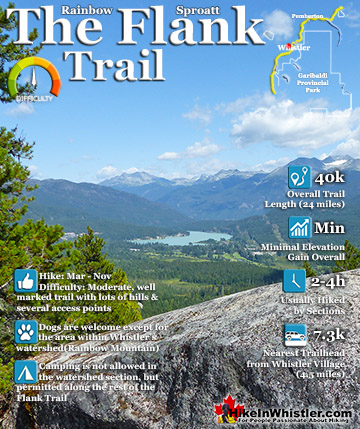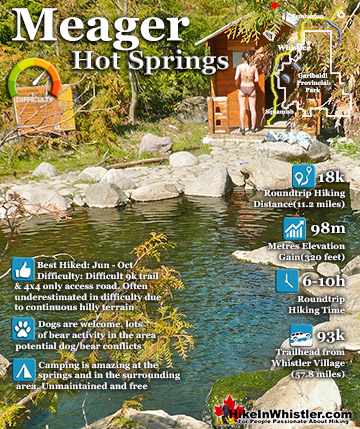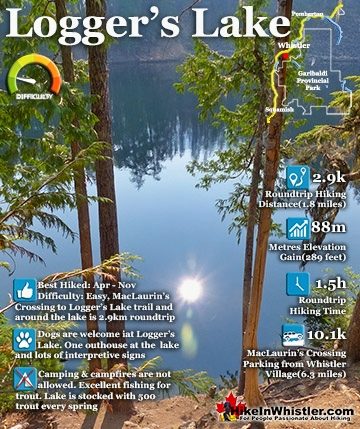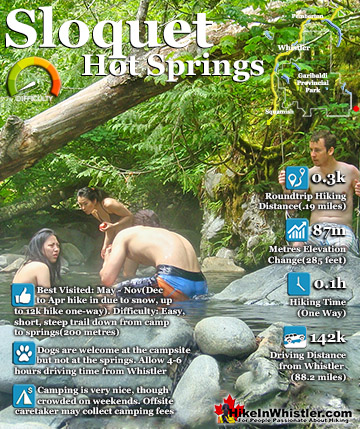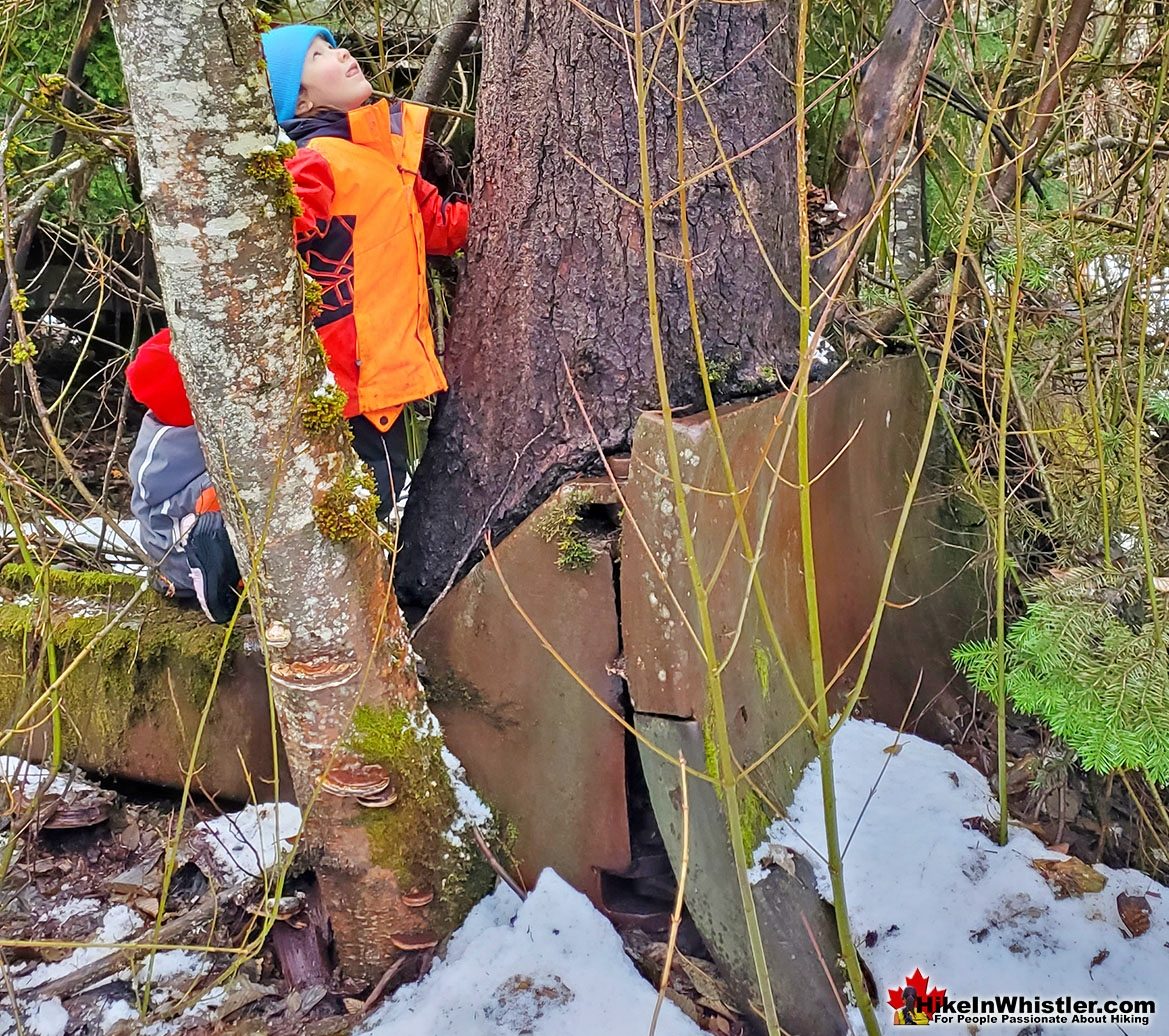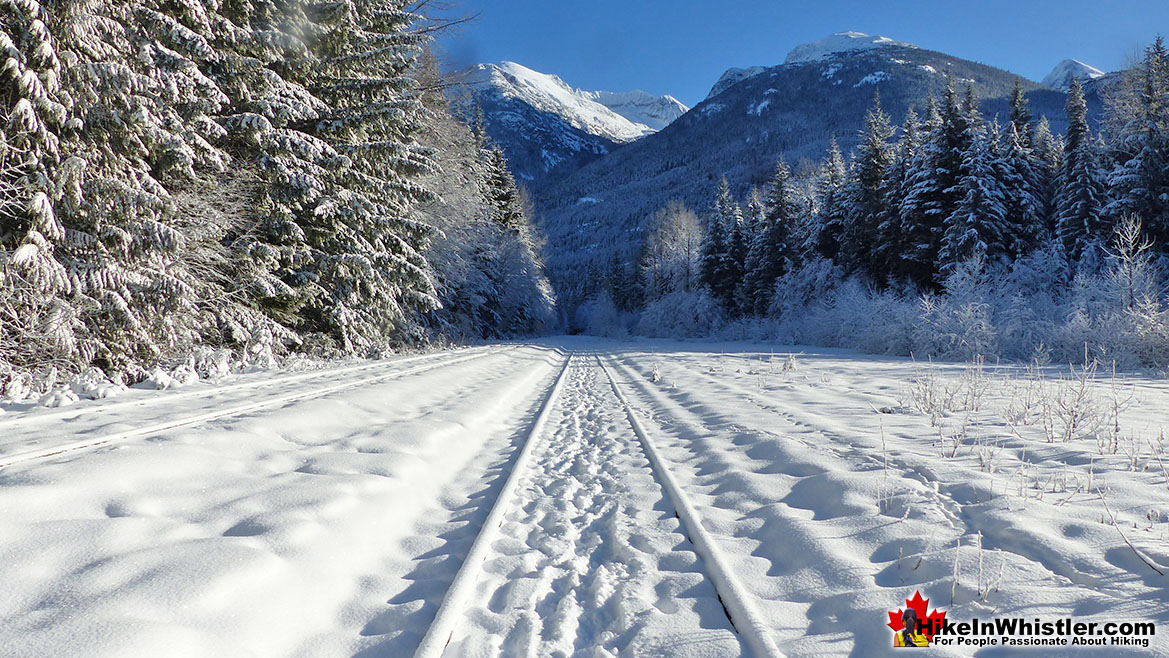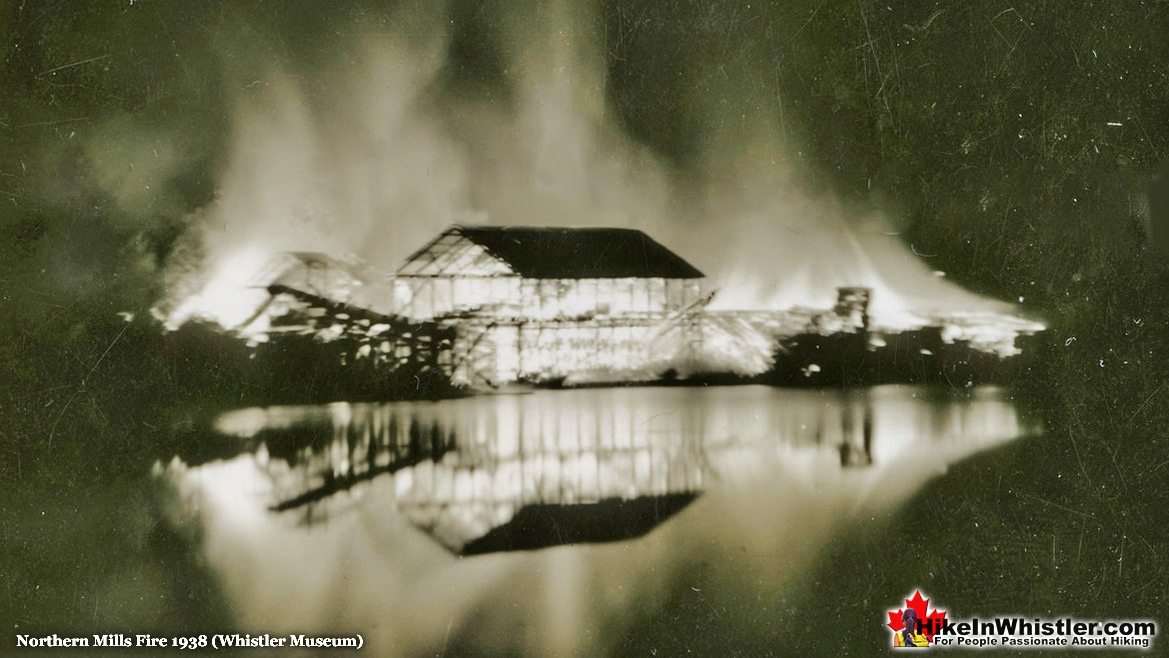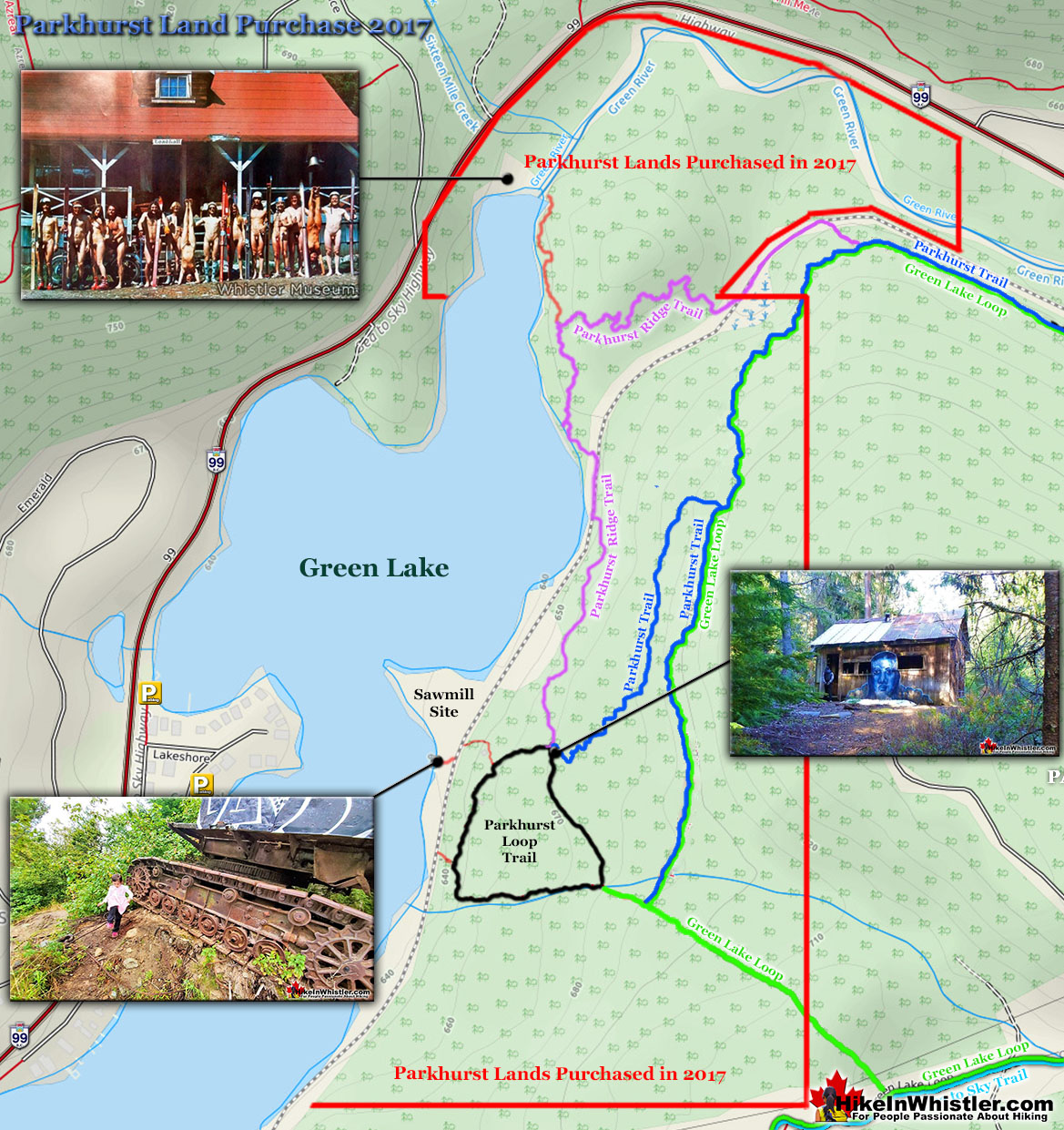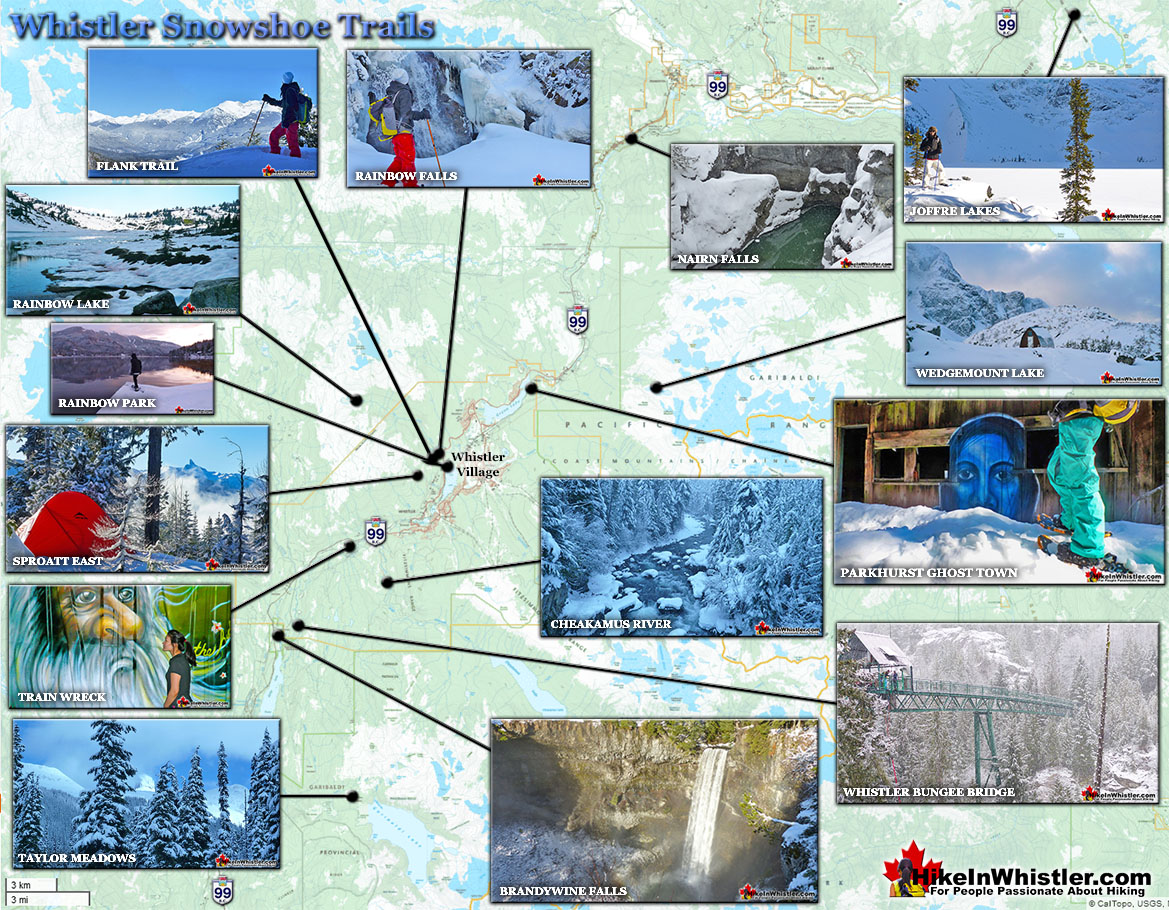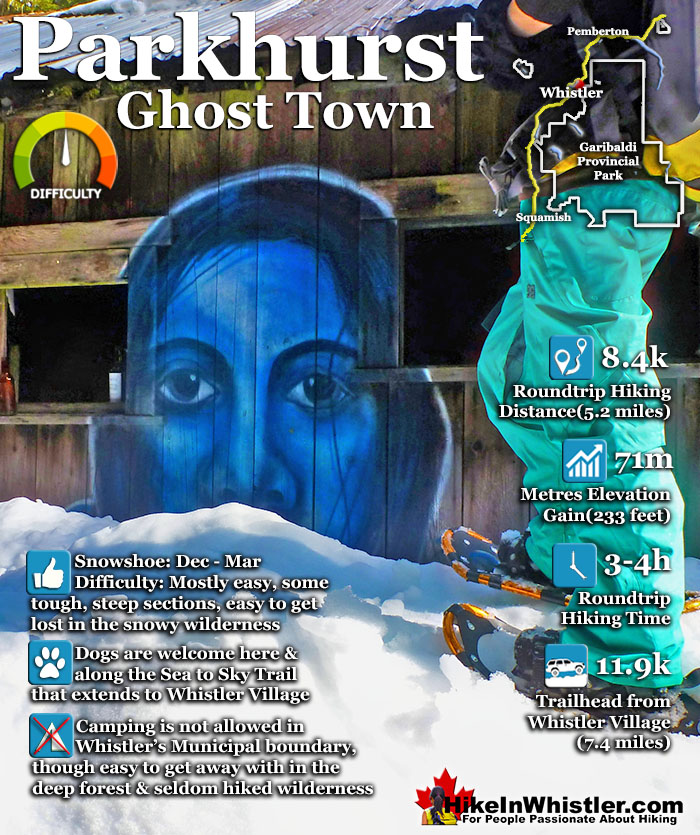
![]() At the north end of Green Lake hides one of the most unusual, interesting and scenic snowshoe trails in Whistler, Parkhurst Ghost Town. From the 1920’s to 1950’s a small logging town with several dozen houses and a sawmill, the town quickly vacated in 1956 when the sawmill ceased operating. Decades of snowy winter crushed the old sawmill and all but two of the old houses. Various types of logging machinery, old vehicles, trucks, Caterpillar tractors and a Cletrac tractor lay in the forest unmoved for almost seventy years.
At the north end of Green Lake hides one of the most unusual, interesting and scenic snowshoe trails in Whistler, Parkhurst Ghost Town. From the 1920’s to 1950’s a small logging town with several dozen houses and a sawmill, the town quickly vacated in 1956 when the sawmill ceased operating. Decades of snowy winter crushed the old sawmill and all but two of the old houses. Various types of logging machinery, old vehicles, trucks, Caterpillar tractors and a Cletrac tractor lay in the forest unmoved for almost seventy years.
 Unusual & surreal place
Unusual & surreal place Historical artifacts hidden everywhere
Historical artifacts hidden everywhere Lots of amazing spots to put up a tent
Lots of amazing spots to put up a tent Frozen Green Lake access in the winter
Frozen Green Lake access in the winter Famous Toad Hall house was here!
Famous Toad Hall house was here! Stunning views of Green Lake
Stunning views of Green Lake Forgotten, remote corner of Whistler
Forgotten, remote corner of Whistler Little hidden world with lots to see
Little hidden world with lots to see Fun to get lost in the maze of trails
Fun to get lost in the maze of trails Access road not plowed in winter
Access road not plowed in winter
Whistler Snowshoe Trails
![]() Blueberry Trail
Blueberry Trail ![]() Brandywine Falls
Brandywine Falls ![]() Cheakamus River
Cheakamus River ![]() Elfin Lakes
Elfin Lakes ![]() Flank Trail
Flank Trail ![]() Joffre Lakes
Joffre Lakes ![]() Nairn Falls
Nairn Falls ![]() Parkhurst Ghost Town
Parkhurst Ghost Town ![]() Rainbow Falls
Rainbow Falls ![]() Rainbow Lake
Rainbow Lake ![]() Rainbow Park
Rainbow Park ![]() Sproatt East
Sproatt East ![]() Taylor Meadows
Taylor Meadows ![]() Train Wreck
Train Wreck ![]() Wedgemount Lake
Wedgemount Lake
![]() January
January ![]() February
February ![]() March
March ![]() April
April ![]() May
May ![]() June
June ![]() July
July ![]() August
August ![]() September
September ![]() October
October ![]() November
November ![]() December
December
Most of the more interesting features of Parkhurst are hidden by the rapidly growing forest that has buried the once treeless area along Green Lake where the sawmill operated. The heavy machinery is not only enveloped by the forest, but in the case of one of the huge tractor plows is being lifted off the forest floor. Quite a remarkable sight considering that it must weigh close to 4000 kilograms (8818 pounds). Another similar 4 ton plow has managed to resist the lifting force of the forest, but instead has forced a tree to grow in a confined, triangular shape through it. For over sixty years this now large tree has continued to grow to a substantial size while its trunk, within the plow is confined and spilling over the top of the plow. The plow is effectively part of the tree like a giant, triangular collar. The base of the tree has half the diameter within the plow, but fused together they are substantially stronger than the thick trunk that stretches up to the forest canopy. What a marvellous sight that makes you stare in wonder for quite some time. The Parkhurst Plow Tree appears to be an old birch tree is grizzled and cracking with age, much harder to recognize than the smooth, white bark of younger birch trees plentiful in the forests around Whistler.
The Parkhurst Plow Tree
Today, Parkhurst is a relatively forgotten corner of Whistler where surprisingly little change has happened since the town was abandoned. In 2017 the Resort Municipality of Whistler purchased the Parkhurst land and the long-term plan is to make it into a park with historical murals similar to Rainbow Park. The remaining remnants of the old Parkhurst would be saved and interpretive signs installed. Little work has started yet with the exception of a couple trail signs.

Parkhurst as a Ghost Town
Because of the lack of organized trail work, Parkhurst remains wonderfully wild and disorganized. This seems to fit Parkhurst as a ghost town. The main trailhead/parking area for Parkhurst has no signs at all and the old bridge crossing over Wedge Creek is disintegrating, yet perfectly fits a ghost town. After crossing the skeleton bridge over the crashing white foam of Wedge Creek you emerge from the forest in the huge, wide open railroad wye. The train track from an enormous triangle here which allows trains to turn around. You would expect a large, gravel, industrial clearing to be ugly, however in the winter under a metre of snow it is surprisingly beautiful. Following the train tracks you see rabbit and deer tracks crisscrossing the tracks through the otherwise perfectly smooth expanse of snow. In the distance you see Rainbow Mountain snow covered in the distance. Looking back, you see the jagged, pure white peaks of Mount Cook, Armchair Glacier and Wedge Mountain framed by blue sky.
In the summer you can hike to Parkhurst by the Parkhurst Trail from the north or the Sea to Sky Trail/Green Lake Loop from the south. The Parkhurst Trail is just 2.6 kilometres one way, and the Sea to Sky Trail/Green Lake Loop if you start from Lost Lake Park is 6.3 kilometres one way. In the winter months when Lost Lake is taken over by pay use cross country skiing and snowshoeing, access to the Sea to Sky Trail is effectively blocked, leaving the Parkhurst Trail the only winter access trail. Often in January and February Green Lake freezes enough to walk across to Parkhurst, however it can be sketchy due to the danger of thin ice. The gravel access road to the unmarked trailhead to the Parkhurst Trail is not plowed in the winter, so usually by December the road becomes too deep with snow to drive. Parking can be found at the highway turnoff just a kilometre from the trailhead. This extra kilometre makes snowshoeing to Parkhurst about 3.6 kilometres. Roundtrip with the Parkhurst Loop Trail and a bit of exploring you are looking at about 8.4 kilometres or about 4 hours in total.
Parkhurst Trail Stats:
Driving There: 12 minutes north of Whistler Village(11.9 kilometres/7.4 miles) to winter parking at Wedgemount Lake/Hwy 99 turnoff. Hiking Distance: 3.6 kilometres/2.2 miles, one way from the winter parking to Parkhurst via the Parkhurst Trail. Hiking Time: 1.5 hours there, and 1.5 hours back. Start Elevation: 627 metres/2057 feet. End Elevation: 698 metres/2290 feet. Elevation Gain: 71 metres/233 feet. Fees: None Campsites: No Camping Allowed: No Difficulty: Moderate, mostly easy with some steep and winding terrain. Some trails are not well marked and tricky to follow. Kid Friendly: May be too long for some kids, but plenty of fun things to see. Stroller Friendly: No Dog Friendly: Yes
Parkhurst Trail & Parkhurst Ridge Snowshoe Trail
![]() In the winter months you likely will have to park near the Sea to Sky Highway turnoff to Wedgemount Lake. Depending on the snow you may have to park before crossing the bridge over Green River. Most years you can usually park in the big area after you cross the bridge. You then snowshoe along the logging road to the right for 1 kilometre to the unmarked parking area and trailhead for Parkhurst. There are two big, yellow gates here which may be your only indication you have reached the trailhead. The Parkhurst Trail starts at the colourful cement, car blocking barricade and into the forest. Almost immediately you come to the old, crumbling vehicle bridge over Wedge Creek.
In the winter months you likely will have to park near the Sea to Sky Highway turnoff to Wedgemount Lake. Depending on the snow you may have to park before crossing the bridge over Green River. Most years you can usually park in the big area after you cross the bridge. You then snowshoe along the logging road to the right for 1 kilometre to the unmarked parking area and trailhead for Parkhurst. There are two big, yellow gates here which may be your only indication you have reached the trailhead. The Parkhurst Trail starts at the colourful cement, car blocking barricade and into the forest. Almost immediately you come to the old, crumbling vehicle bridge over Wedge Creek.

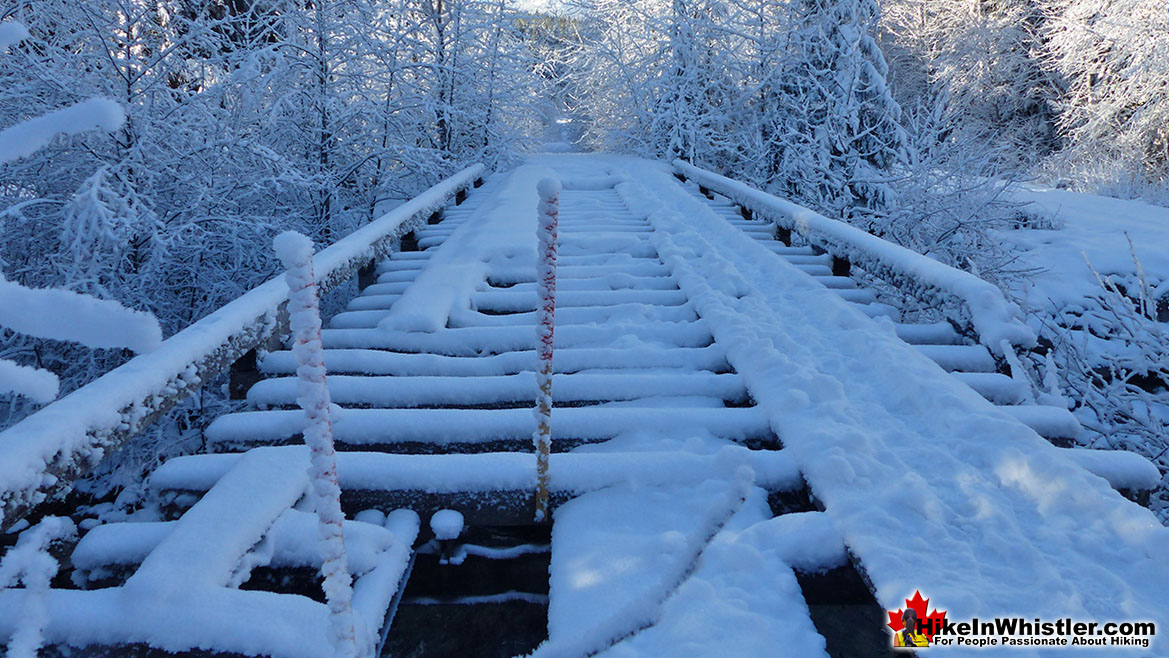
Across the bridge on your left, you will see an old picnic table and fire ring next to Wedge Creek. Just a couple dozen metres further along the main trail and you will pass an unmarked trail on your left. This is the Green Lake Loop, and is a beautiful trail that takes you through the nice forest here parallel to Wedge Creek and merges with the Sea to Sky Trail near Wedge Creek Falls Falls. Continuing past the Green Lake Loop, you will emerge from the forest and into the wide-open area with the train tracks turn around area, known as a wye in railroad industry.
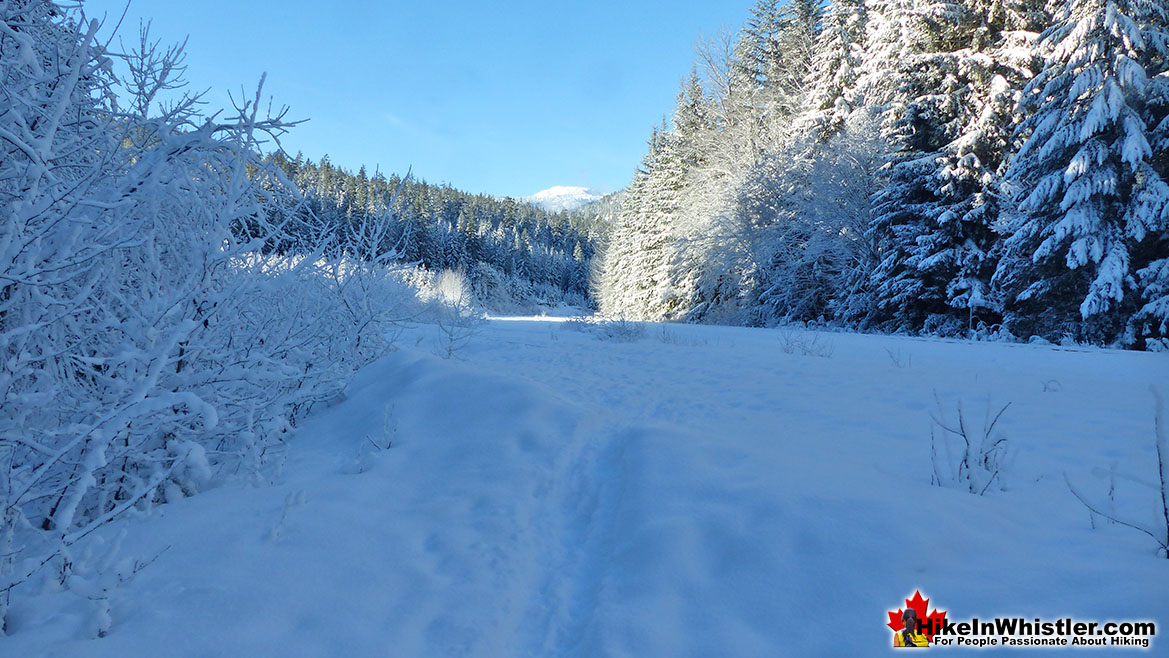
Snowshoeing Across the Parkhurst Wye
Cross the Parkhurst Wye tracks that bend to the left and continue walking parallel to the main tracks on your right. After about 400 metres, at the far end of the Parkhurst Wye, just past where tracks merge again you will see the Parkhurst Trail on your left and a small Green Lake Loop/Parkhurst Trail sign. Follow this trail into the deep, dark, beautiful forest.

The Parkhurst Snowshoe Trail
After about 500 metres along this very straight trail you will come to an abrupt fork in the trail. The left fork is where the Parkhurst Trail continues for 1 kilometre to connect with the Parkhurst Loop Trail. This section of trail is not terribly exciting and not nearly as nice at the Parkhurst Ridge Trail which is found by taking the right fork.

Parkhurst Trail and Parkhurst Ridge Trail Compared
The Parkhurst Trail does have the advantage of being shorter, easier and more direct than the Parkhurst Ridge Trail. The ideal route to take is the Parkhurst Ridge Trail to Parkhurst and the Parkhurst Trail back to the trailhead. The Sea to Sky Trail is boring, a bit longer, though less hilly, straighter and very easy to follow when there is a lot of snow on the ground. From the Parkhurst Trail, the right fork takes you immediately down to the train tracks. Bear left onto the train tracks and in about 100 metres you will see a marshy area on your left and the train track bend to the right further ahead. On your right you will see a faint trail ascend up the rock cliff. This is the Parkhurst Ridge Trail. The rock slope flattens and you will find yourself on a ridge above the train tracks. This is where you can judge your enthusiasm for this route as you can see the terrain and know whether you will be able to find your way though in heavy snow. If you change your mind you can retreat back down to the tracks and backtrack to the Parkhurst Trail. Or you could snowshoe along the train tracks, which is a shortcut past the hilly sections and rejoin the Parkhurst Ridge Trail back up to the ridge overlooking Green Lake or forward up the ridge to the Parkhurst Loop Trail. The train tracks are a convenient short cut, but of course travelling on train tracks is not legal and if a train comes you should disappear into the forest and not be seen.
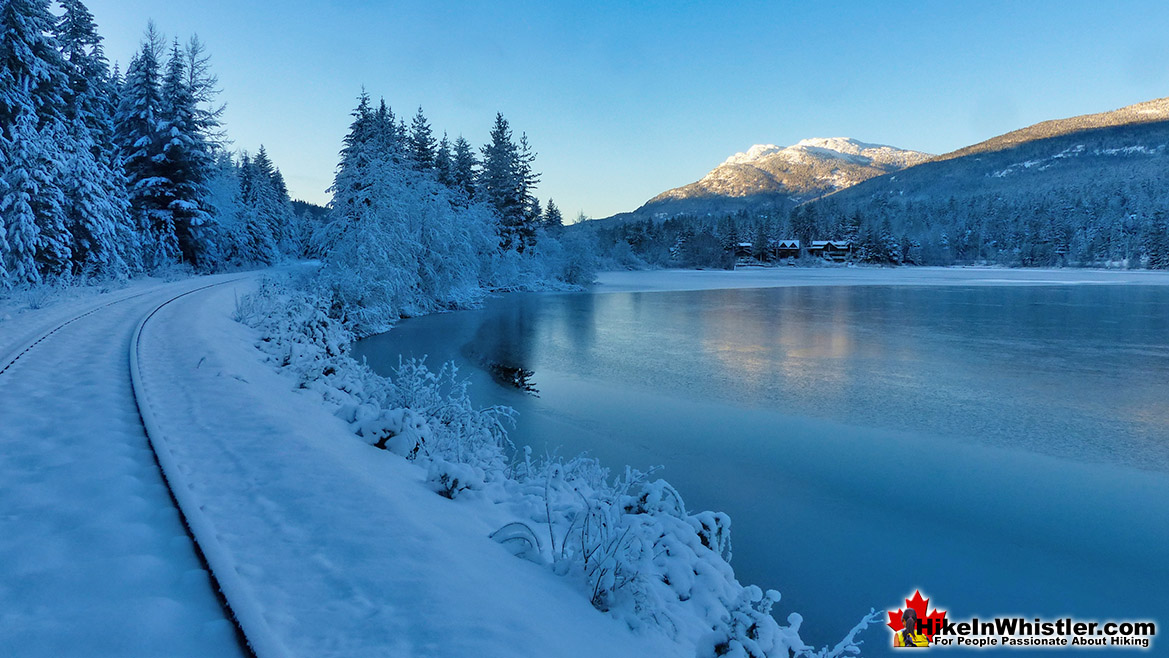
The Parkhurst Ridge Trail is very well marked with tree ribbons and lots of deadfall trees that fell across the trail and have been chainsawed out of the way. This trail is extremely windy as it ascends through the hostile, yet strangely beautiful, rocky terrain with fallen trees everywhere. You will get a workout for the next 600 metres as you wind through the forest, in and out of gullies. Despite the numerous trail markers, it is easy to lose the trail momentarily, however you always have a good sense of where Green Lake is ahead from occasional gaps in the trees. This trail is magnificent on a sunny day as the trees are sparse and you catch some great views of Whistler Mountain and Blackcomb Mountain framed by trees. There are several beautiful hilltops to sit down and take a breather as well as plenty of amazing grassy areas to put up a tent if you are keen for a serene winter getaway. Pictured here is a beautiful summer morning in Parkhurst before the fog has burned off.
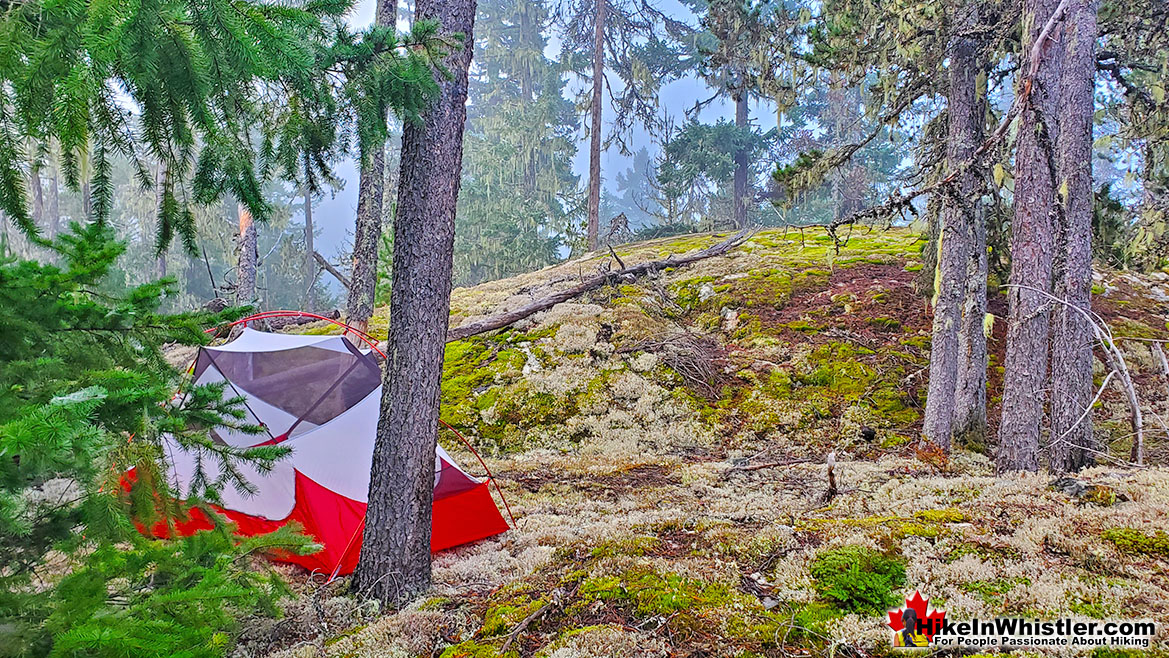
The Parkhurst Ridge Trail ascends up, snaking in and around some rocky hills before abruptly ascending down into the deep, dark emerald forest next to Green Lake. You should see a faint trail veer off to the left running parallel with Green Lake on your right. Follow this beautiful trail for a couple hundred metres and it snakes through the forest and rocky outcrops. There are a couple faint trails here, but don’t worry about getting lost as long as you keep Green Lake on your right you will ascend up to the amazing viewpoint at the top of Parkhurst Ridge.
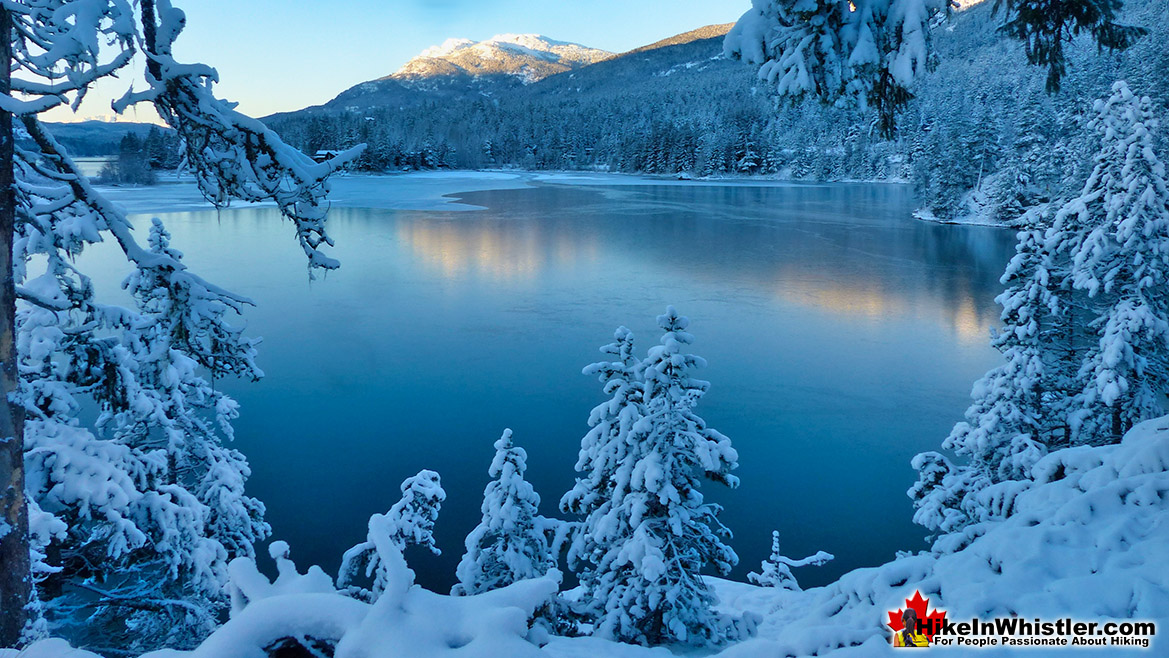
Snowshoeing Beautiful Parkhurst Ridge
Parkhurst Ridge is an incredible spot for a lot of reasons. Of course, the view is spectacular. Absurdly vivid green coloured water. Snowy mountains all around. Wonderfully varied clifftop terrain with easily accessible cliff plateaus leading like giant steps down to the water. The forest on the ridge is sparse enough to be always sunny, but with plenty of trees to make it feel secluded. The trees on the ridge are quite impressive as well. Many absurdly hardy and contorted lodgepole pines grow in bizarre ways. Bent over from harsh winters they have a strange beauty in their hardy, weather battered forms. One particular lodgepole pine on the ridge, judging by its trunk diameter must be over 50 years old, but stands only a couple metres tall. Next to this extraordinary krummholz tree is an absolutely incredible place to camp. A flat, mossy clearing at the edge of the cliff, surrounded by trees but plenty of views of Green Lake. Just a couple metres away is the flat clifftop overlooking Green Lake with the sturdy, old picnic table nestled against the trees.

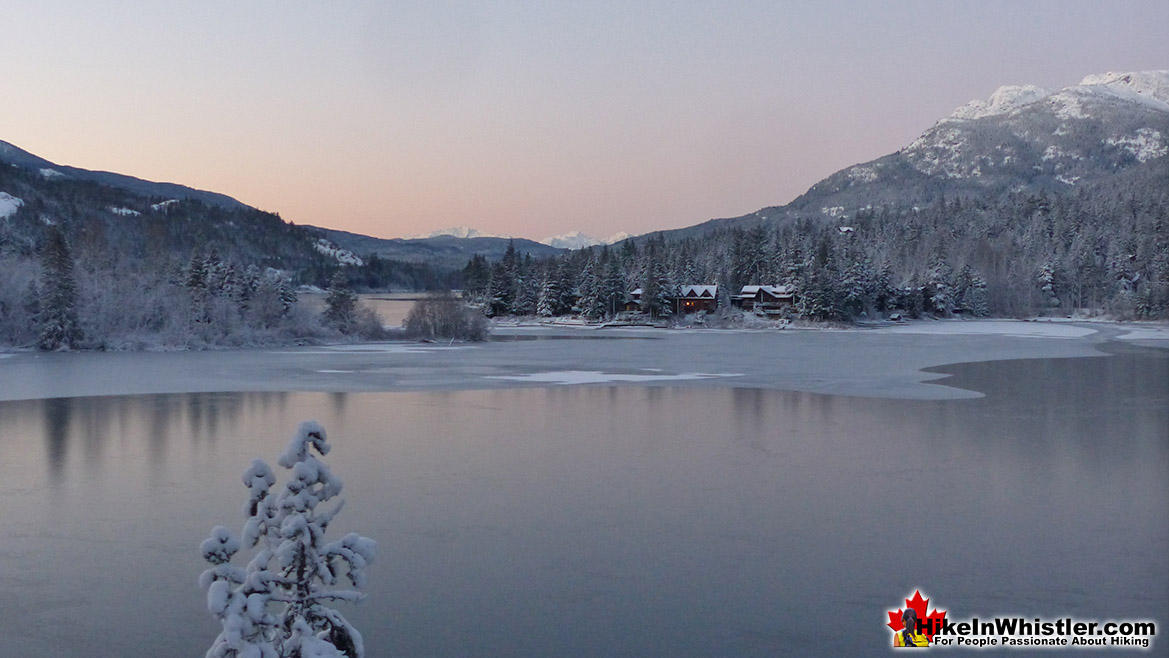
The Parkhurst Ridge Trail continues down from here and emerges at the train tracks. If you cross the tracks and walk for a couple minutes keeping Green Lake on your right you will see a tiny wooden hut on your left. This is an old crumbling relic that used to store supplies for maintaining the railroad. Next to this little house you will see the continuation of the Parkhurst Ridge Trail.
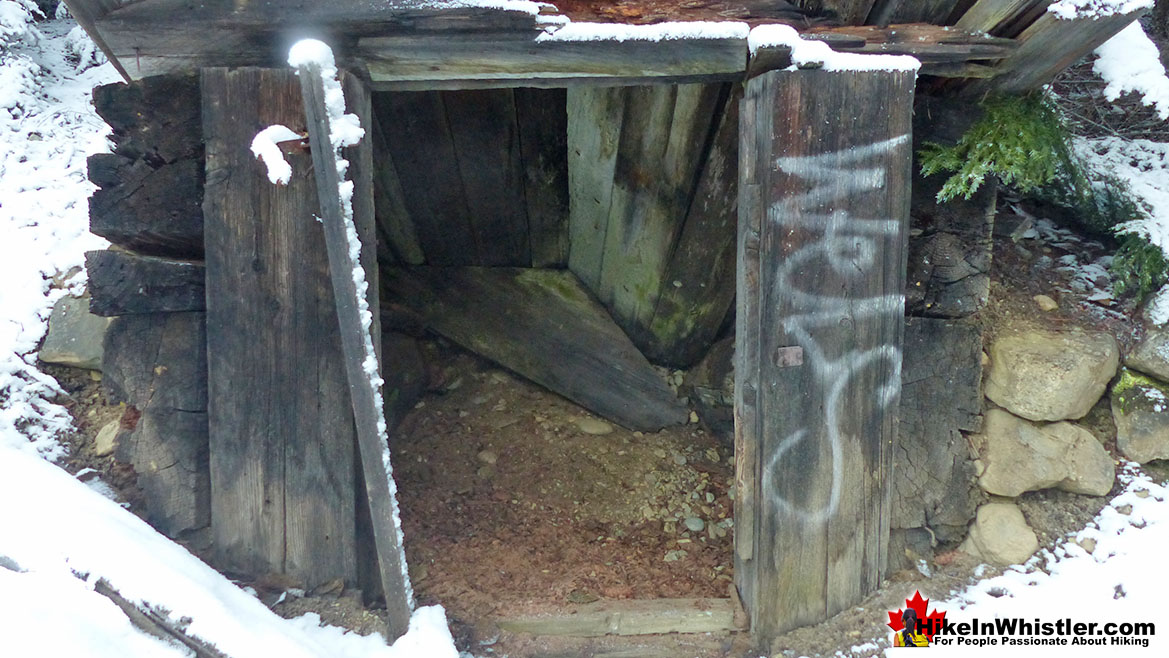

It quickly ascends up along the ridge for about 500 metres and into a winter wonderland forest overlooking Green Lake. Here you will start to see signs of the old ghost town. Old cans and bottles and further along a few flattened houses.
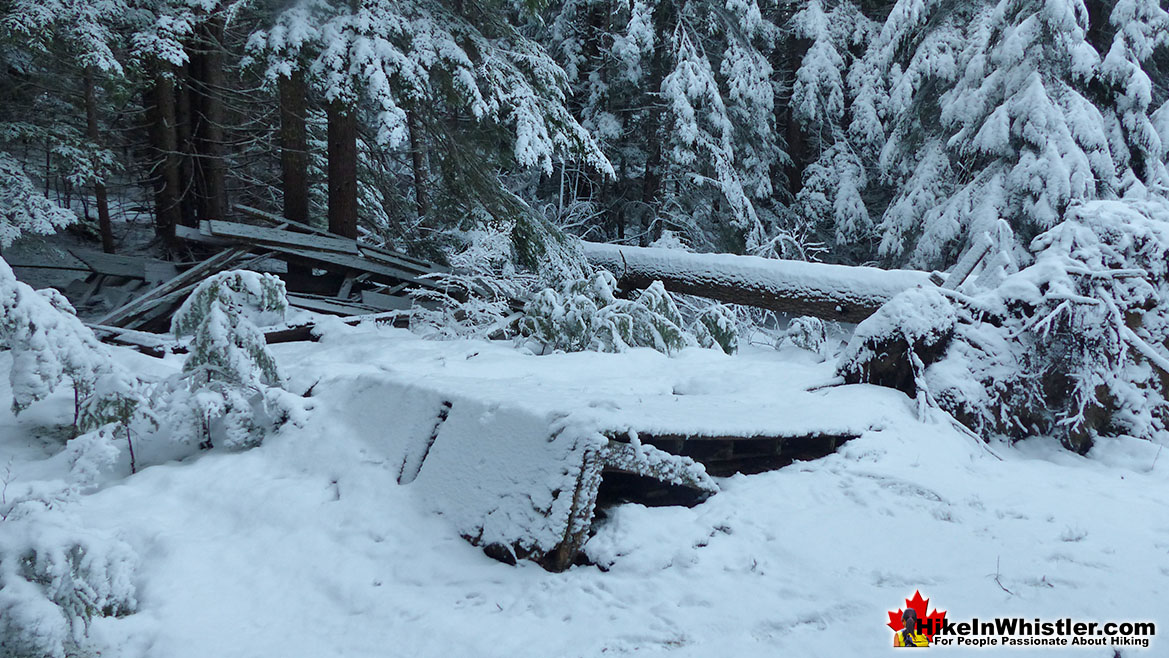
Faint trails zigzag through the trees and lead to the well-defined Parkhurst Loop Trail. This triangle shaped trail runs throughout the old town tracing a route that was once a dirt road. The old road then extends directly out of the town, opposite to Green Lake and connects to the Green Lake Loop trail and the Sea to Sky Trail that run parallel to the lake all the way to Lost Lake and Whistler Village.
Snowshoeing the Parkhurst Loop Trail
![]() The Parkhurst Loop Trail is roughly a triangle with each side about 300 metres long. This trail runs through the now deep forest where most of the houses once stood in Parkhurst. Part of the loop trail was once an old gravel road which explains how the various wrecked vehicles managed to get there. Wrecked, old trucks from the 1950’s, an old car from the 1970’s and dozens of collapsed houses lay rotting along this trail. It is fun to wander through the forest here as you can never tell what you will find around the next bend in the trail. The triangle shaped loop trail surrounded by deep forest is strangely disorienting. You find yourself wandering for a while in a direction you are sure is away from Green Lake, only to suddenly emerge from the forest just steps from the water. Unlike other hiking trails in Whistler where you have a set destination, at Parkhurst you have a non-stop series of curious structures, beautiful sections of forest and endless great lake views.
The Parkhurst Loop Trail is roughly a triangle with each side about 300 metres long. This trail runs through the now deep forest where most of the houses once stood in Parkhurst. Part of the loop trail was once an old gravel road which explains how the various wrecked vehicles managed to get there. Wrecked, old trucks from the 1950’s, an old car from the 1970’s and dozens of collapsed houses lay rotting along this trail. It is fun to wander through the forest here as you can never tell what you will find around the next bend in the trail. The triangle shaped loop trail surrounded by deep forest is strangely disorienting. You find yourself wandering for a while in a direction you are sure is away from Green Lake, only to suddenly emerge from the forest just steps from the water. Unlike other hiking trails in Whistler where you have a set destination, at Parkhurst you have a non-stop series of curious structures, beautiful sections of forest and endless great lake views.
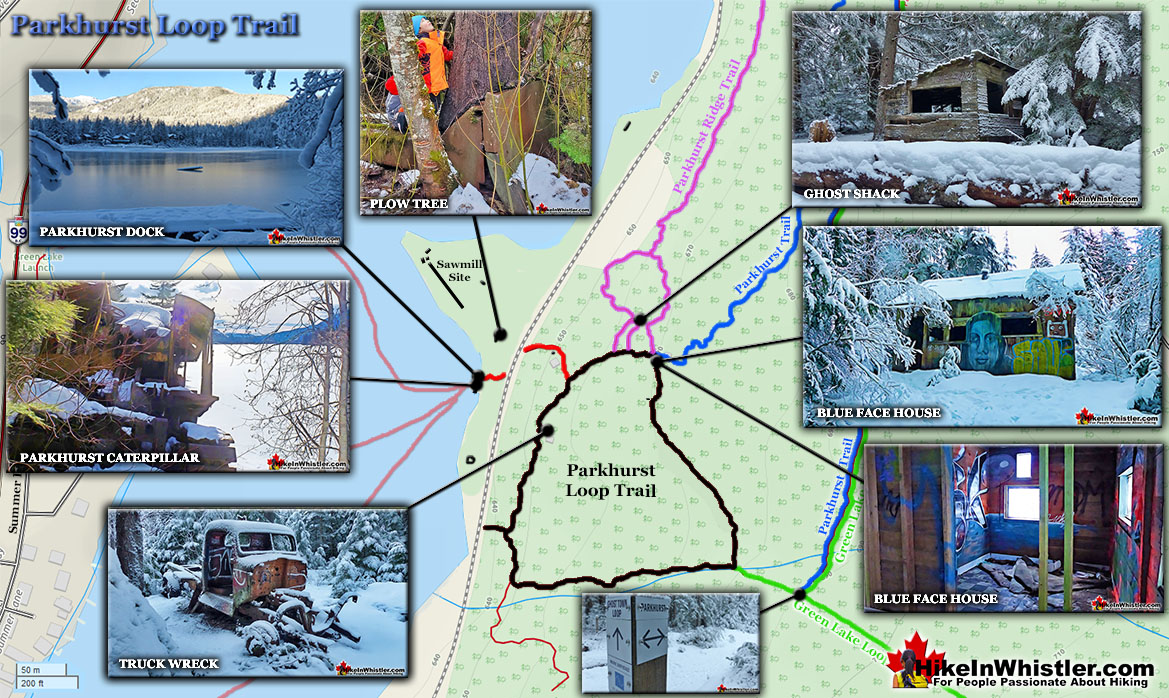
Parkhurst Ghost Shack
There are just two houses left standing in Parkhurst and both are found near where the Parkhurst Ridge Trail meets the Parkhurst Loop Trail. The Ghost Shack is a small, hilariously leaning one room house that looks ready to fall over at any moment. It is pretty solidly put together though as it has been leaning over like this for at least a decade now. The floor has long disintegrated and its slope seems to be from one side sinking into the dirt or at least rotting from the bottom up. One side, on the outside you will see painted, “Ghost Shack”, and further along the side, “I’d be there to dry each tear”.
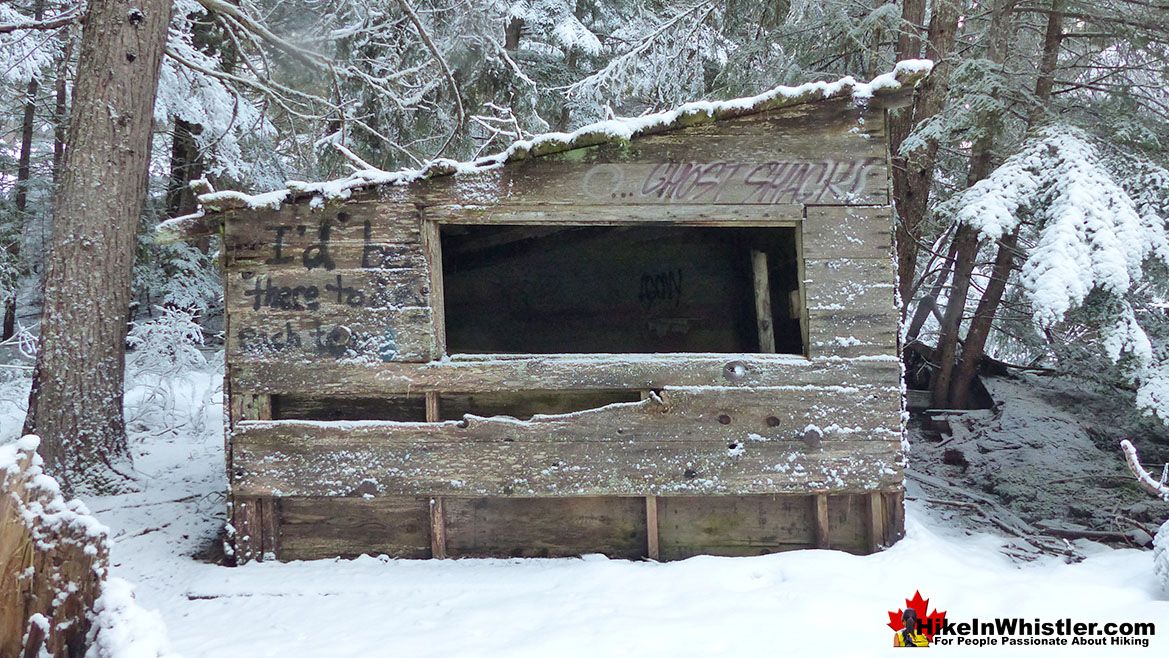
Parkhurst Blue Face House
Not far from the Ghost Shack is the much sturdier Blue Face house. Back in 2011 Kris Kupskay, a Whistler local and now professional muralist painted a hauntingly beautiful, blue face on the side of this house. This beautiful mural, along with the fact that this is the last fully intact house in Parkhurst makes it the most well known and photographed structure in the old ghost town. It is difficult to figure out why the Blue Face house outlasted all the others, but it appears to still be quite structurally sound. The old metal roof is very well intact and all the walls are fairly solid.
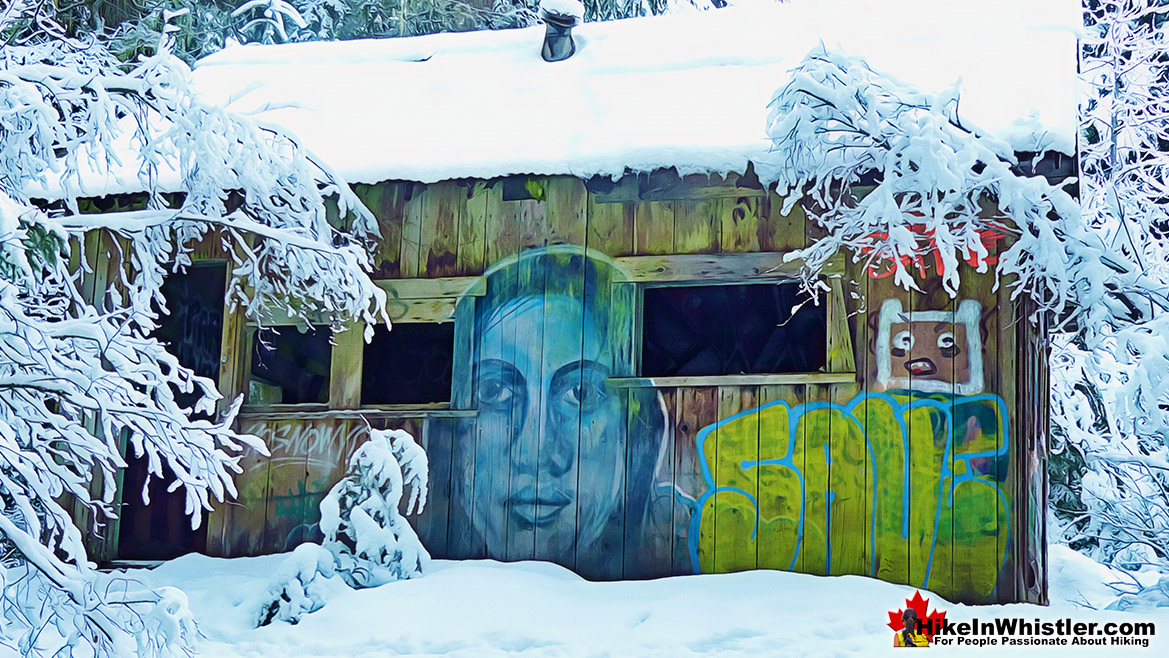
The only significant damage seems to be from visitors yanking curtains down or smashing floor boards and wall panels. Any windows that may have existed are long gone and there is no longer a door. A hole in the ceiling has been clawed open to look into the attic which is also somewhat intact with insulation still lining between the two by four ribs. There is even a cute little chimney poking out of the room, though of course the stove is long gone. There was an old rickety metal bed frame covered with a foam mattress, but now that is mangled across the floor.
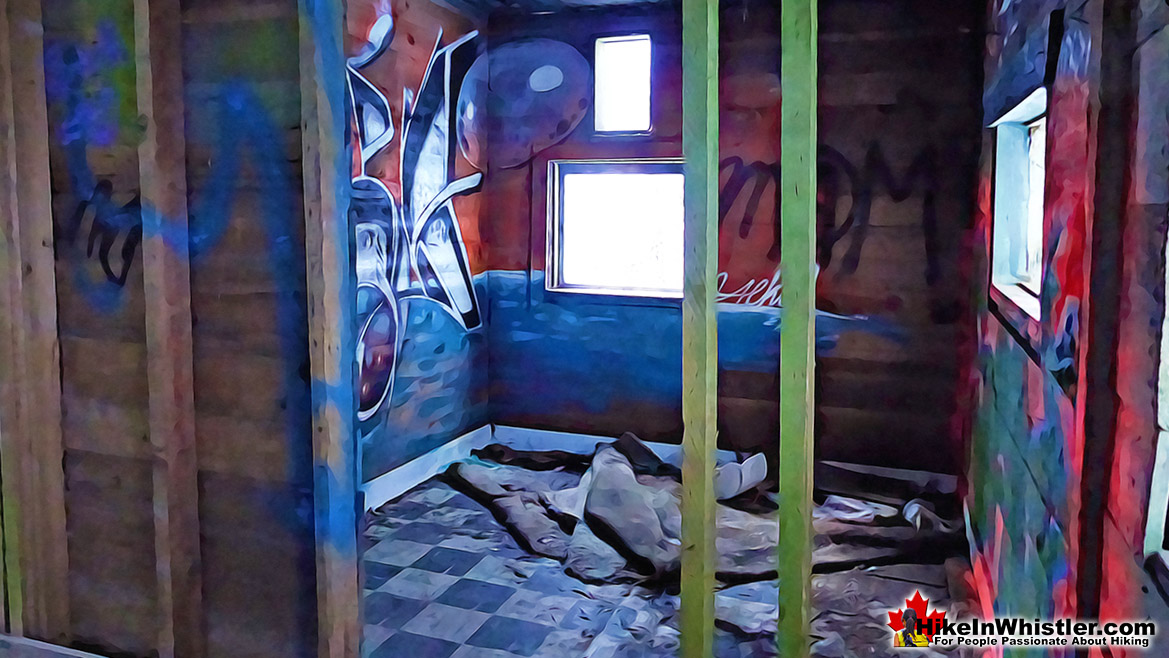
Snowy Parkhurst Tractors and Sawmill Site
The Parkhurst Loop Trail has a couple side trails that lead you to the train tracks and shore of Green Lake. The huge Parkhurst Caterpillar can be found menacingly perched on the shore here. If you don’t mind a bit of bushwhacking you can find your way into the point of land that juts out into Green Lake and was the site of the Parkhurst Sawmill. Here you will find another Caterpillar tractor being consumed by the forest. This is the one is being lifted off the forest floor by the relentless growth of trees. If you look at the huge, solid steel plow you will see it is suspended off the ground by several powerful trees.

Next to this Caterpillar is another wonderfully strange interaction between a plow and the forest. Another huge, steel plow lays in the forest and the forest has grown through it. One tree has managed to push its way through a triangle opening and grow into a fairly large tree, despite being forced through a narrow opening near the ground.
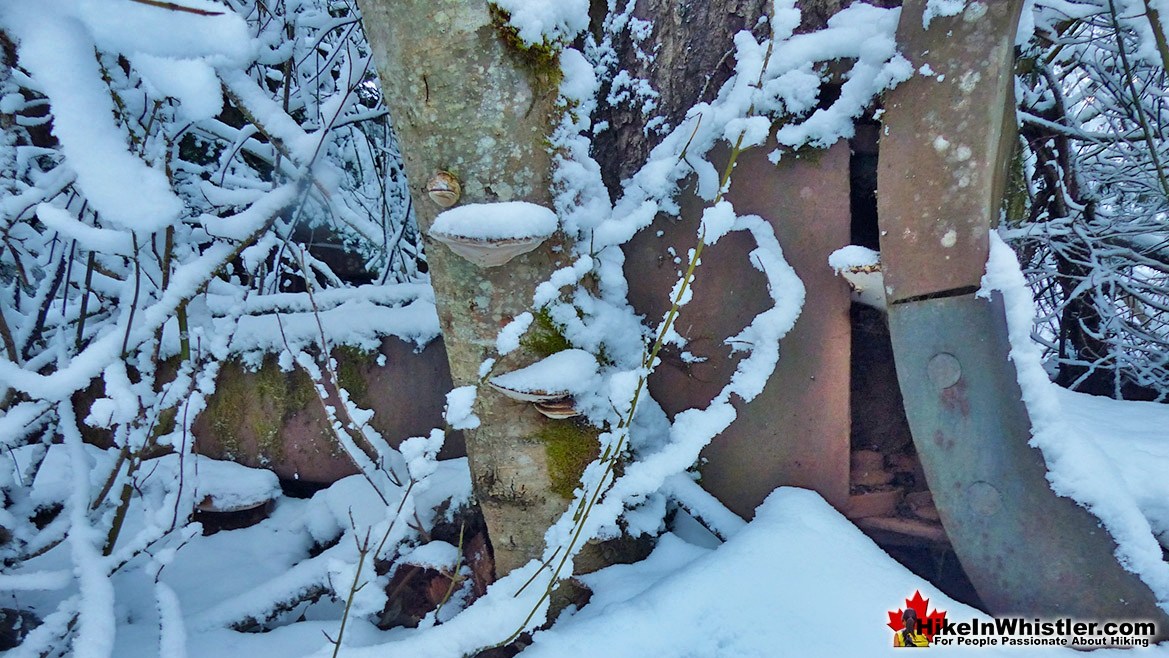
Bushwhacking to the Parkhurst Sawmill Site
Bushwhacking further into the forest you will find the abandoned Cletrac tractor and plenty of remnants of the old sawmill. The metal roof of the sawmill lays hidden under the forest floor, though reveals its presence by preventing large trees to grow. This accounts for the large, tree-free area within the otherwise deep forest. If you can manage to bushwhack your way out of the old sawmill site and follow the shore of Green Lake for a few dozen metres you will come to a nice, peaceful clearing in the forest. A few cement foundations indicate that the sawmill extended along the lake and old pictures show that this was a raised platform next to the train tracks for loading and unloading.
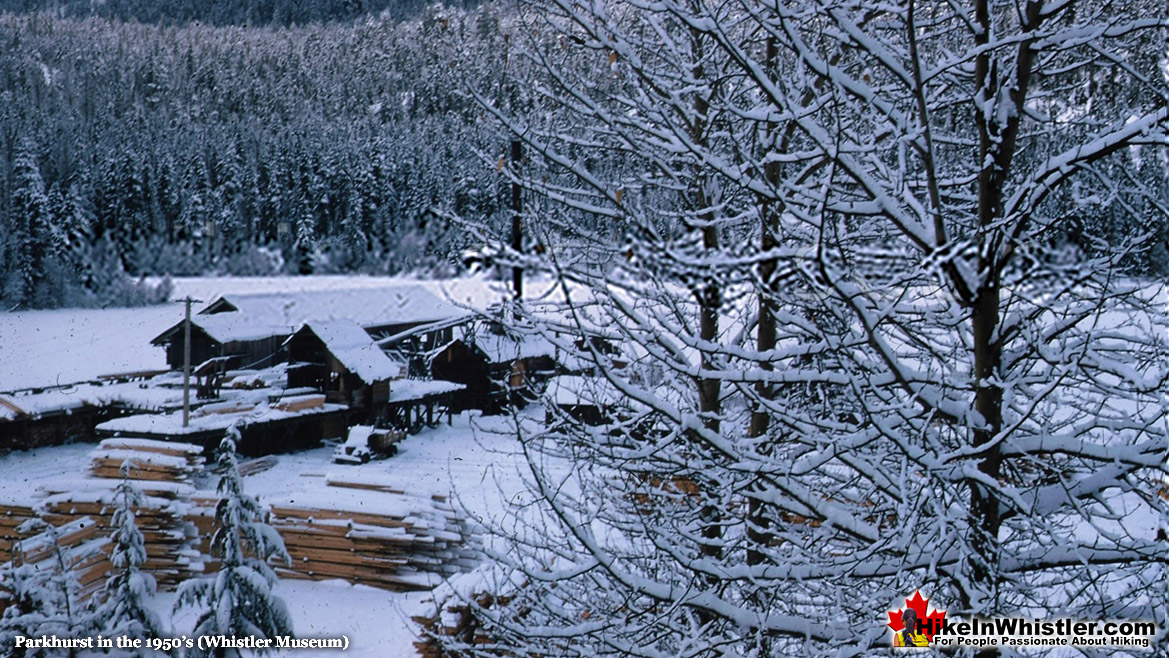
Snowshoeing the Sea to Sky Trail to Parkhurst
![]() The Sea to Sky Trail, which runs over thirty kilometres through Whistler, extends around the back side of Green Lake, past Parkhurst and through to Lost Lake and Whistler Village. The access road to the Parkhurst trailhead is actually part of the Sea to Sky Trail and it continues up the gravel road past the yellow gate next to the normal, summertime parking for Parkhurst. There used to be a Sea to Sky Trail sign near the yellow gate, but it is no longer there. Down the logging road near the highway at the Wedgemount Lake turnoff and winter parking for Parkhurst, you will see Sea to Sky Trail signs.
The Sea to Sky Trail, which runs over thirty kilometres through Whistler, extends around the back side of Green Lake, past Parkhurst and through to Lost Lake and Whistler Village. The access road to the Parkhurst trailhead is actually part of the Sea to Sky Trail and it continues up the gravel road past the yellow gate next to the normal, summertime parking for Parkhurst. There used to be a Sea to Sky Trail sign near the yellow gate, but it is no longer there. Down the logging road near the highway at the Wedgemount Lake turnoff and winter parking for Parkhurst, you will see Sea to Sky Trail signs.
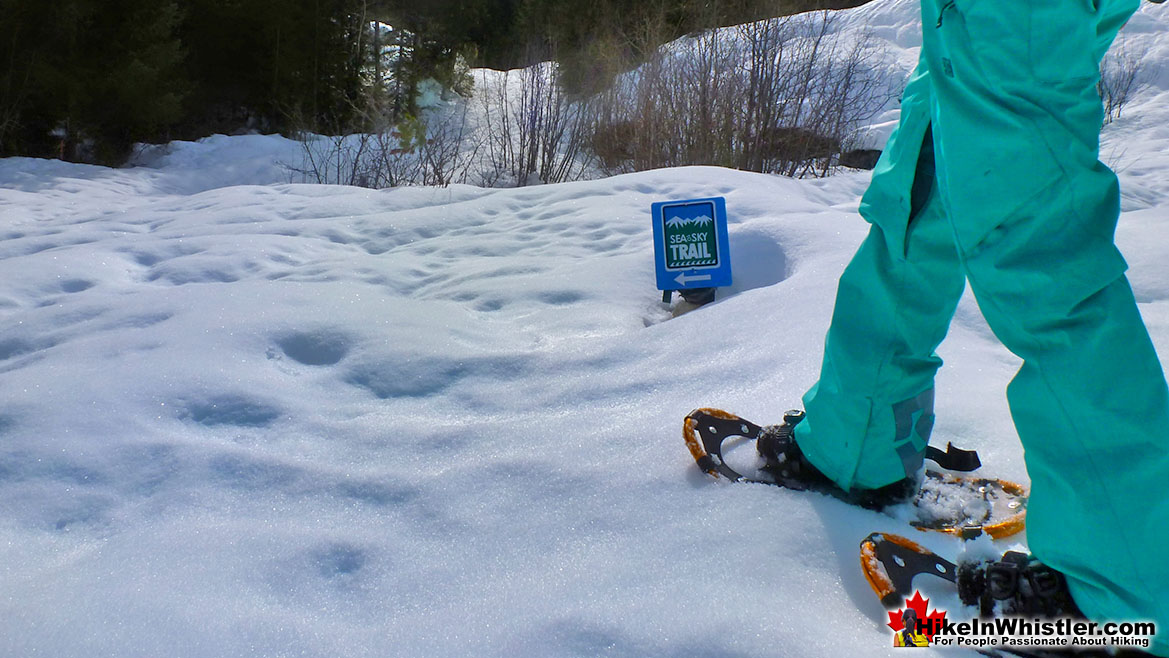
Though the Sea to Sky Trail is overall very beautiful and scenic, the couple kilometres running around the back of Parkhurst are not. There are really only two reasons to snowshoe the Sea to Sky Trail in the winter. One is that you can make a nice circle route by snowshoeing the Parkhurst Trail, Parkhurst Ridge Trail, the Parkhurst Loop Trail and return via the Sea to Sky Trail. This is what most visitors to Parkhurst do, however the Parkhurst Trail is much nicer than the Sea to Sky Trail and the Parkhurst Ridge Trail is considerably more scenic than both. The other reason to snowshoe the Sea to Sky Trail is that it is very easy to navigate when there is a lot of snow on the ground. It is a gravel road for much of the distance to Parkhurst and hard to get lost.
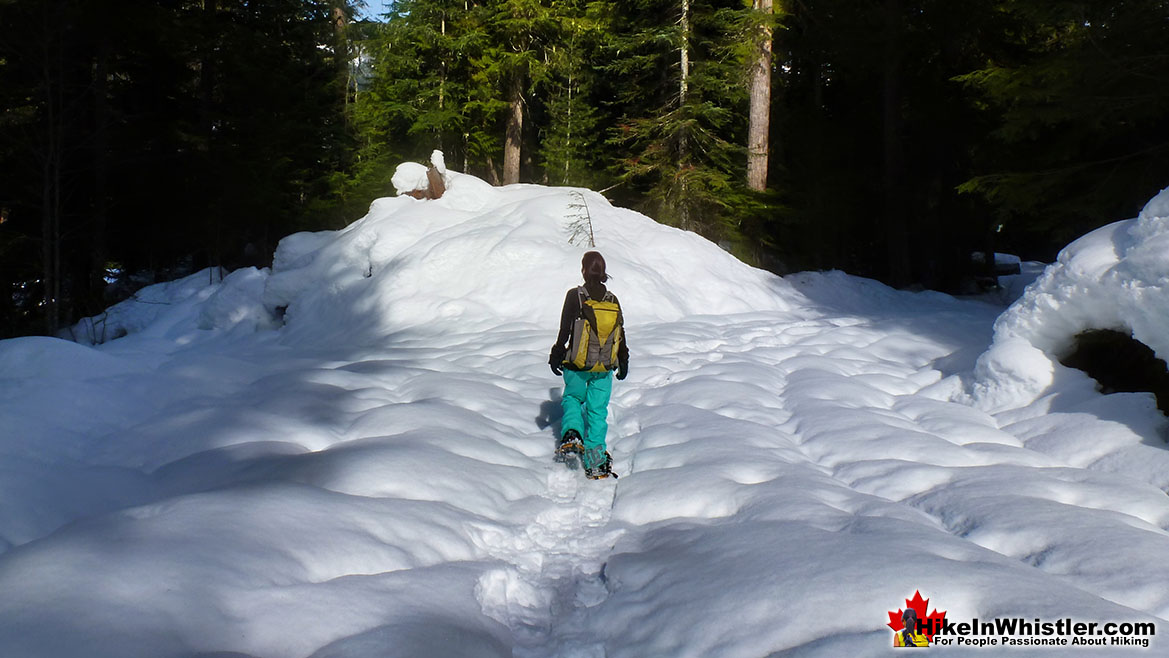
The Parkhurst Trail starts off very easy to follow, however when you get to the Y junction where the Parkhurst Ridge Trail goes right and the Parkhurst Trail continues left it becomes steep and zigzags sharply. Though there are lots of tree ribbons marking the trail, it is still easy to stray in the wrong direction if there is deep snow. The Parkhurst Ridge Trail is similarly challenging and with both trails the tricky sections are less than a kilometre long.
Green Lake Loop Trail and Wedge Creek Falls
![]() The small unmarked trail on your left just 30 metres after you cross the crumbling Wedge Creek bridge is the Green Lake Loop Trail. This very nice, winding section of this trail zigzags through a nice old forest with some good views of Wedge Creek. It ascends up along Wedge Creek for about 1 kilometre before it merges with the Sea to Sky Trail. If you turn left where the trails merge and follow the sound of crashing water you will come to a bridge with a great view of Wedge Creek Falls.
The small unmarked trail on your left just 30 metres after you cross the crumbling Wedge Creek bridge is the Green Lake Loop Trail. This very nice, winding section of this trail zigzags through a nice old forest with some good views of Wedge Creek. It ascends up along Wedge Creek for about 1 kilometre before it merges with the Sea to Sky Trail. If you turn left where the trails merge and follow the sound of crashing water you will come to a bridge with a great view of Wedge Creek Falls.

A faint trail ascends up the right side of Wedge Creek and is immediately beautiful. Various rock shelves jut out over the crashing, emerald water. There is always quite a dramatic log jam making the falls an impressive sight. As you skirt the cliffs up Wedge Creek the crashing water rushes in a wildly zigzagging way below. The trees are fairly well marked with flagging tape which makes hiking along this route fairly easy to follow. In the winter you might be able to cross the creek and follow the marked route that continues across Wedge Creek to link up with the Young Lust Trail and circle back down to the Parkhurst trailhead or continue up Young Lust to where it connects to Comfortably Numb.
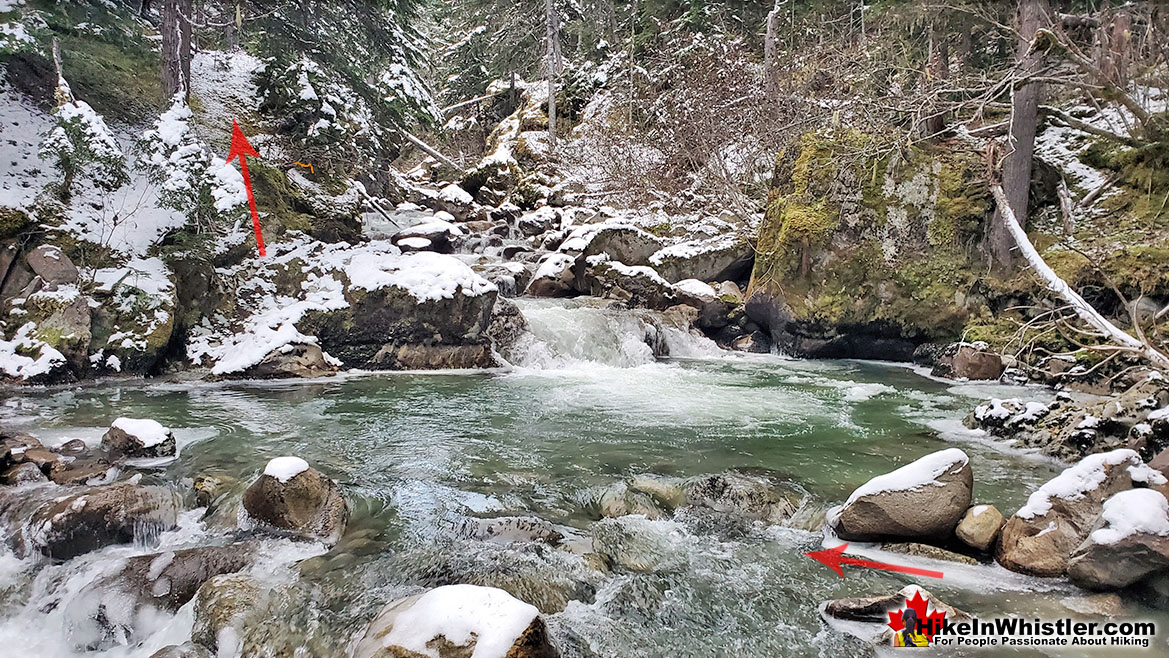
Keep in mind that hiking along Wedge Creek is steep, challenging, but wonderfully fun and scenic. So, unless you are very energetic, you may just venture up part way along this route and return the same way. The nicest sections of Wedge Creek are just above the falls anyway.
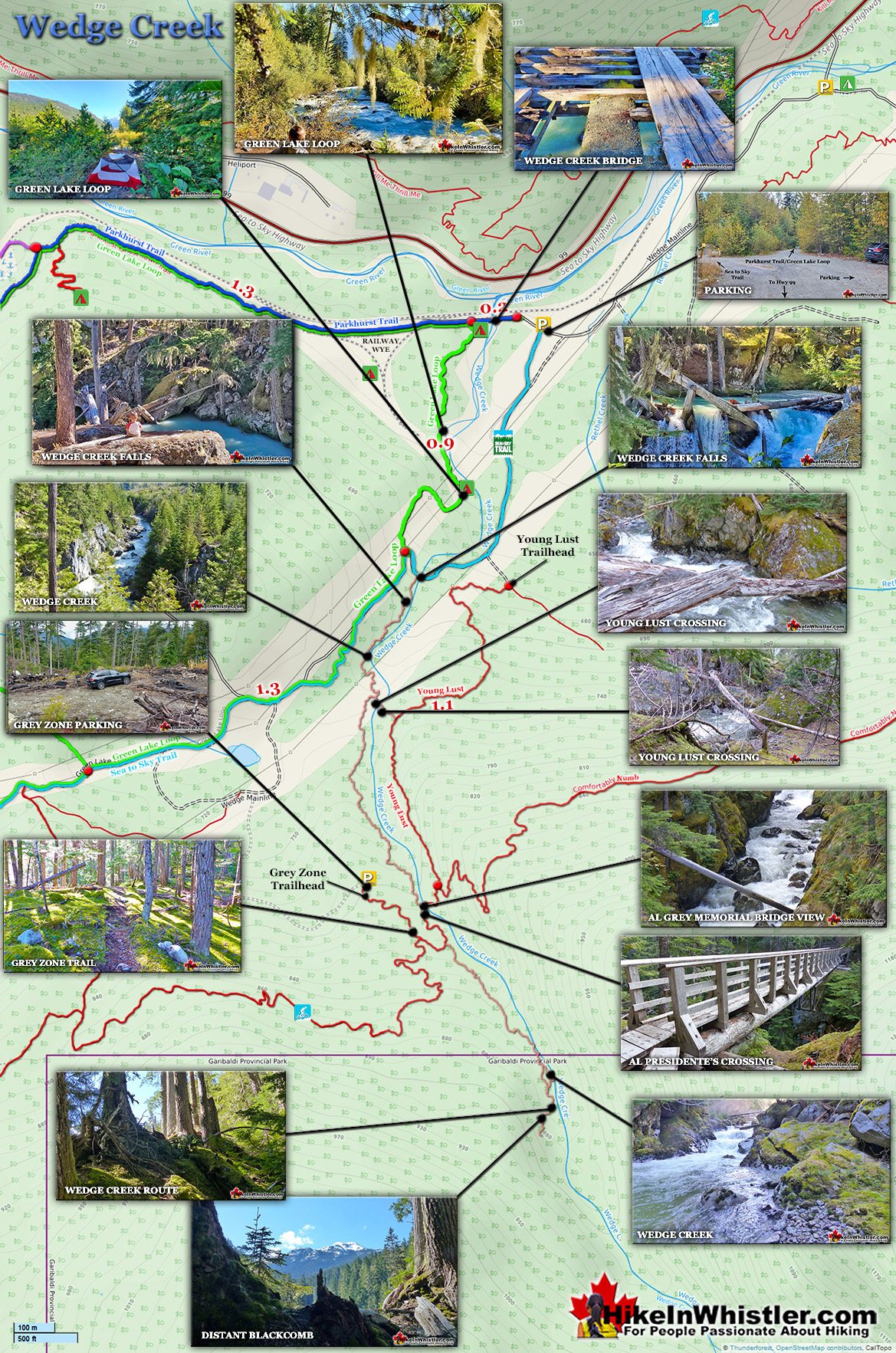
History and Timeline of Parkhurst
![]() The small logging town called Parkhurst came into being in 1926 when the Barr Brothers Logging Company purchased the land from a recent widow looking to sell. Mrs. Parkhurst sold the land and a small house which quickly transformed into several small houses, bunkhouses and a steam powered sawmill on the point of land that still conspicuously juts out from the shore. Soon there were 70 loggers working the mill and living much of the year in the town that was now named after the original owners of the land, Parkhurst. The Great Depression hit the logging industry hard and unable to sell what they produced and the mill went into receivership. In 1932 the mill was purchased by another logging company and was back in business under a new name, Northern Mills. It was to be short lived however, as a fire destroyed the mill in 1938. It was rebuilt and the town once again grew in size to include a school and a store. Parkhurst continued as a small logging town until the logging industry slowed down in the 1950's and in 1956 Parkhurst was finally abandoned.
The small logging town called Parkhurst came into being in 1926 when the Barr Brothers Logging Company purchased the land from a recent widow looking to sell. Mrs. Parkhurst sold the land and a small house which quickly transformed into several small houses, bunkhouses and a steam powered sawmill on the point of land that still conspicuously juts out from the shore. Soon there were 70 loggers working the mill and living much of the year in the town that was now named after the original owners of the land, Parkhurst. The Great Depression hit the logging industry hard and unable to sell what they produced and the mill went into receivership. In 1932 the mill was purchased by another logging company and was back in business under a new name, Northern Mills. It was to be short lived however, as a fire destroyed the mill in 1938. It was rebuilt and the town once again grew in size to include a school and a store. Parkhurst continued as a small logging town until the logging industry slowed down in the 1950's and in 1956 Parkhurst was finally abandoned.

When Whistler Mountain opened as a ski resort in the winter of 1965/66 and Highway 99 was constructed thousands of skiers flocked to Whistler. Transient skiers discovered Parkhurst and lived in some of the remaining houses. Ski bums inhabited every available space to sleep in Whistler and gave birth to the legendary Toad Hall on Alta Lake. Toad Hall, a rented house, became a party house that gained a reputation known Canada wide. In 1969, when the owners discovered what was happening they evicted the residents and demolished the house. Within months, Toad Hall was resurrected near Parkhurst at the north end of Green Lake. The Soo Valley Logging Company had recently vacated their logging camp and it was taken over by skiers. This second incarnation of Toad Hall became the one famously memorialized in the photo of the naked skiers. The photo was taken in the spring of 1973 after it was known that the buildings were to be removed in the summer.
Timeline of Parkhurst
1902: The Parkhurst’s pre-empted a parcel of land along the shore of Green Lake. Little is known about the Parkhurst’s except they built a small house and raised a family.
1926: After Mr. Parkhurst passed away, the Parkhurst’s sold their property to the Barr brothers of Mission, BC. William, Malcolm and Ross Barr moved their lumber operation to the Parkhurst land. They constructed a sawmill and some houses for workers and named it the Parkhurst Mill.
1928: Malcolm Barr drowned in Green Lake when he fell from a boat while working logs on the lake.
1930: The Parkhurst Mill did well for the first three years of operation until the Great Depression hit and demand for lumber evaporated. Unable to even cover the costs of transporting the lumber, the Parkhurst Mill went into receivership. With the mill closed and all the workers gone, the receiver hired Ross Barr and his wife to watch over the mill until a buyer could be found. They were paid just $50 per month and a barrel of coal oil to burn in their lamps.
1932: Parkhurst was purchased by B.C. Keeley and Byron Smith.
1933: The Parkhurst Mill was reopened under the name Norther Mills. Ross Barr was hired along with Denis DeBeck to manage the new mill.
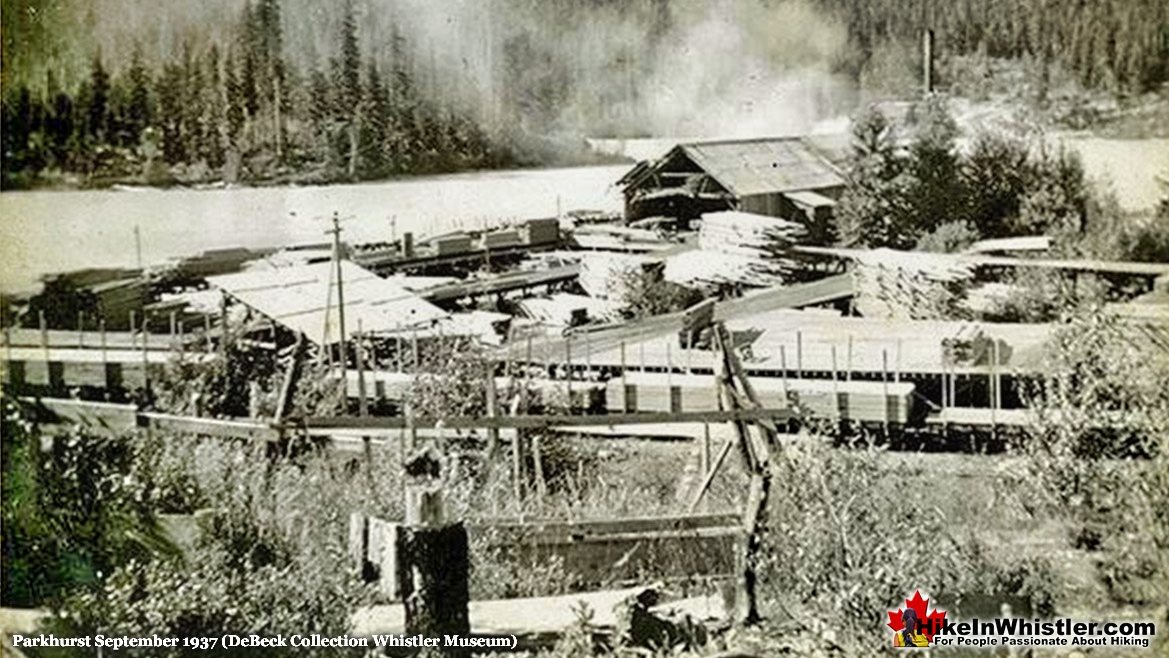
1938: Northern Mills was destroyed by fire and what could be salvaged was moved to the north end of Lost Lake and rebuilt there.
1939: The mill was moved back to Parkhurst as the Lost Lake location was too far from the railroad to be feasible. The new mill at Parkhurst was rebuilt and operations resumed. Parkhurst grew in size as the mill prospered once again.
1948: The Kitteringham family (Olie, Eleanor and their children Ron, Jim and Linda) lived at Parkhurst from 1948 until the mill shut down in 1956. During that time Parkhurst employed about 30 men, including millwright Olie. For the first few years the Kitteringhams were the only family to stay at Parkhurst through the winter. They made extra money shovelling the snow off the mill’s buildings so that they wouldn’t collapse in the spring when the rains made all that snow very heavy.
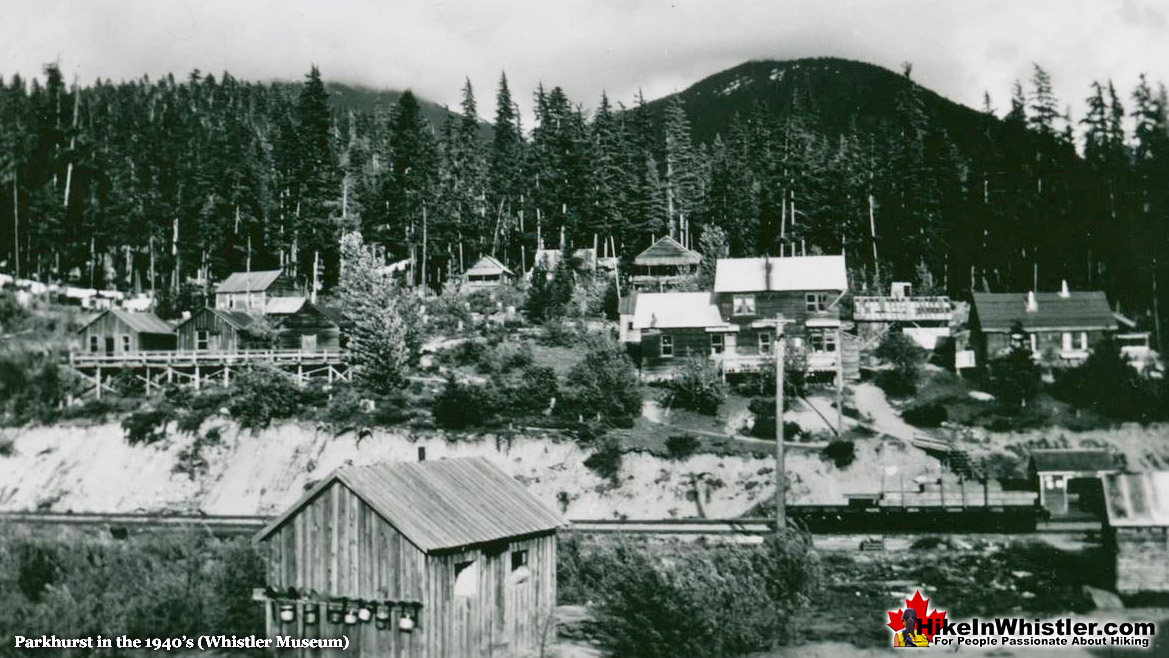
1956: The mill at Parkhurst closed and the town was abandoned. The Caterpillar RD8 hidden in the forest would likely have been abandoned within months of the picture taken below. It is located in the clearing between piles of lumber in the bottom right of the picture. The old Cletrac tractor, also buried in the forest of the old sawmill site was abandoned in the vicinity of the big pile of lumber in the middle right of the picture. The large gemel tree that the Cletrac is lodged against today and the huge old birch tree that would one day grown into the impressively surreal Parkhurst Plow Tree have yet to take root in the sandy gravel and mostly tree-less sawmill yard.
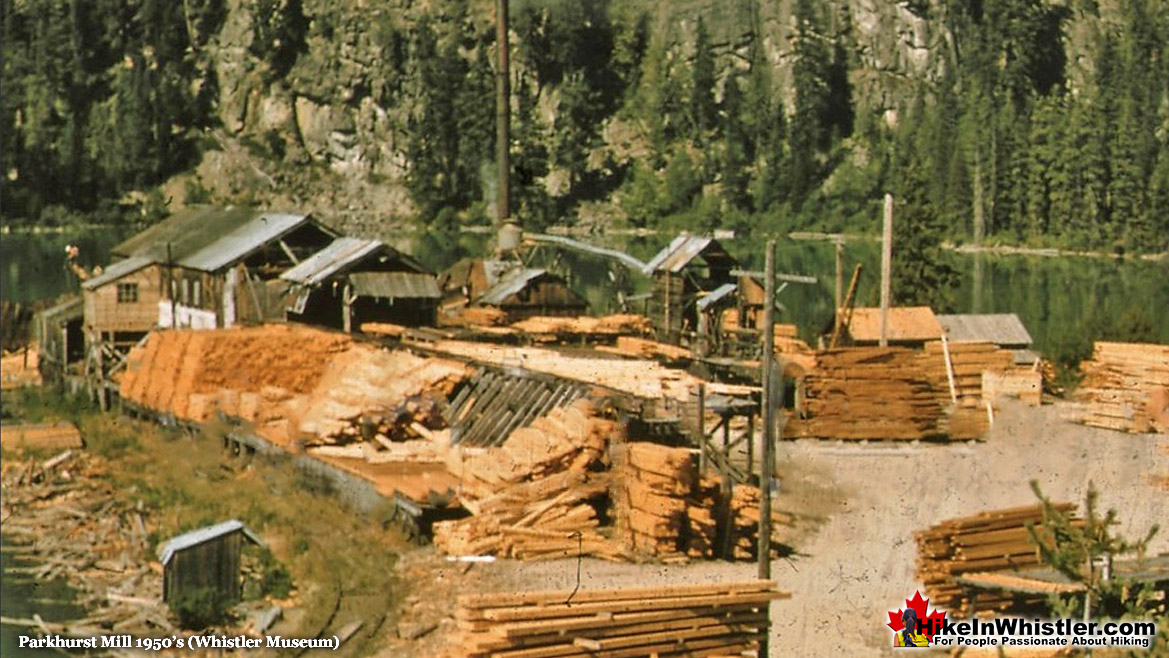
Below is another picture of Parkhurst taken in the 1950's. The picture was taken from the clearing in the middle of the sawmill yard and appears to be just steps from where the Cletrac sits today. The only remaining house standing in Parkhurst, if you don't count the Ghost Shack, is unfortunately not visible. The Blue Face House looks similar to the one in the middle, left of the picture, behind the houses in the foreground. The Blue Face House would be further behind that house, roughly in line with the large tree in the middle foreground of the picture.
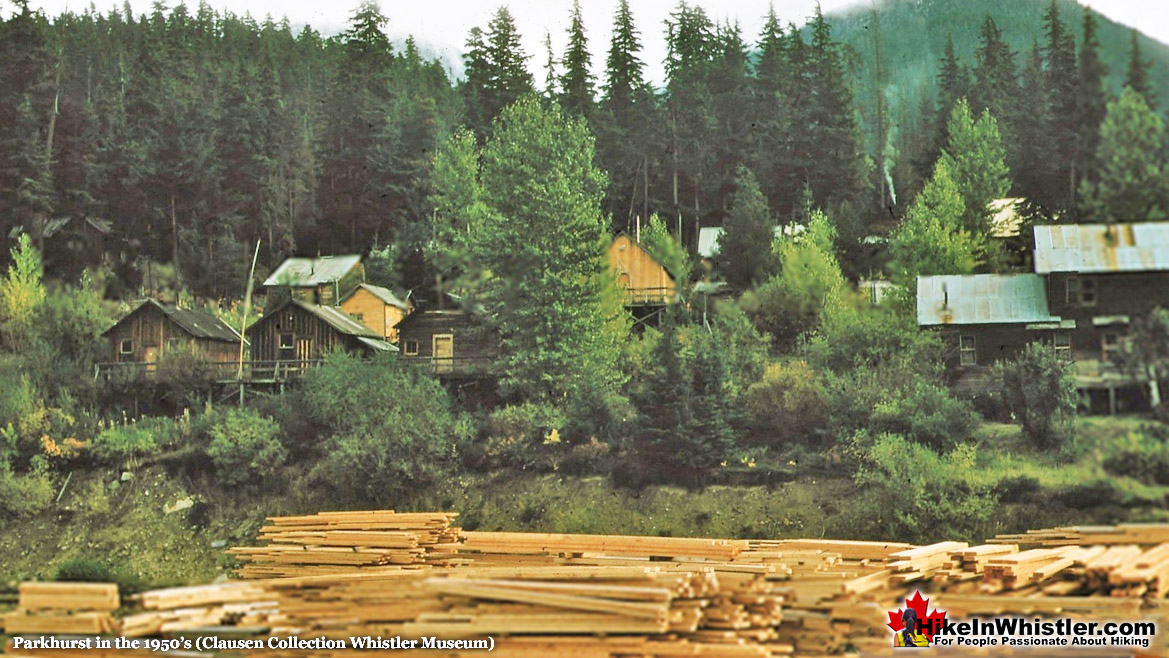
1966: Highway 99 was completed to Pemberton and Whistler Mountain opened for skiing in the winter of 1965/66. The sudden influx of visitors to Whistler led to the remaining houses in Parkhurst being occupied by skiers. On Alta Lake a rental house began its transformation into what would famously become known as Toad Hall.
1969: RCMP issued a court order to the residents of Toad Hall on Alta Lake to be evicted and the building demolished. The residents of Toad Hall threw one last farewell party before leaving. Soon after the second incarnation of Toad Hall developed in the abandoned Soo Valley Logging Camp at the northern end of Green Lake near Parkhurst.
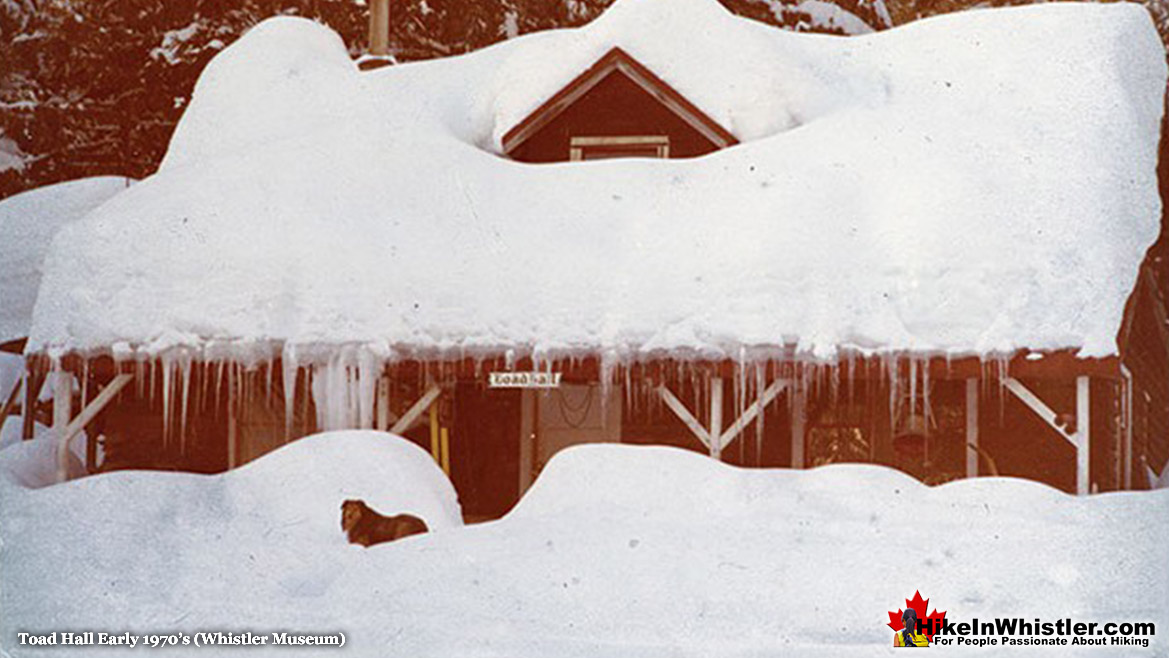
1973: The second Toad Hall was scheduled for demolition in the summer of 1973. That spring, knowing their time there was nearing its end a bunch of the residents gathered for a photo in their ski gear and nothing else. Photographer Chris Speedie printed 10000 copies in poster size and sold for two or three dollars each. Terry “Toulouse” Spence sold copies along the World Cup ski circuit.
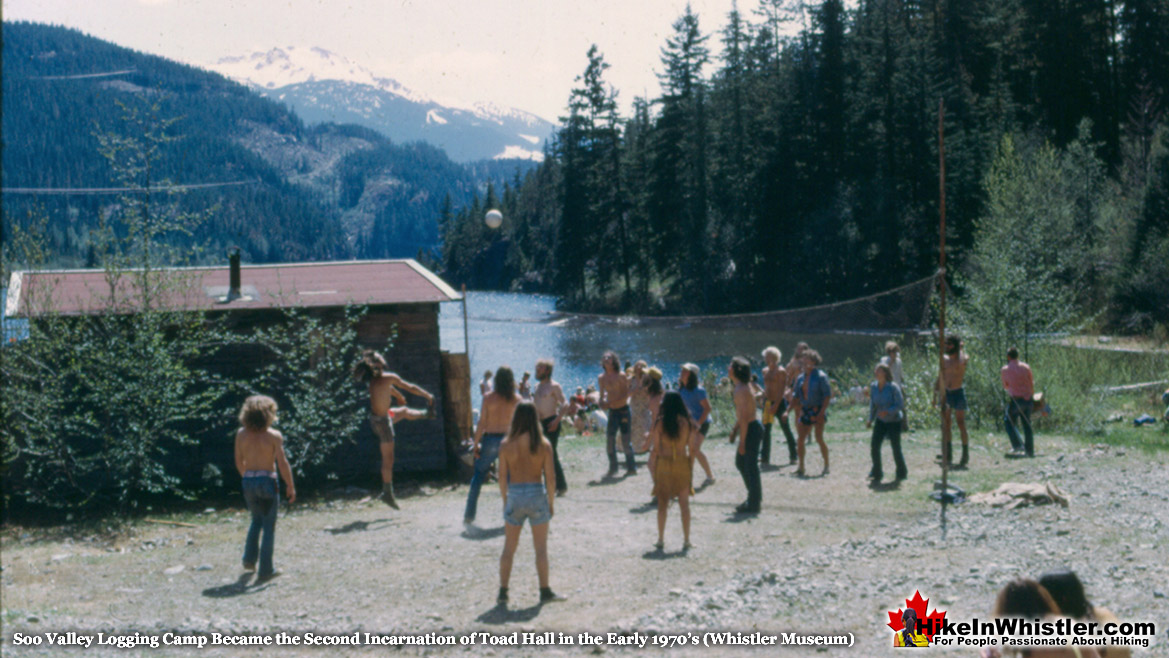
Below is a picture taken at the same location in 2021. Where the Soo Valley Logging houses and Toad Hall once stood is now a beautifully serene little corner of Whistler. With no access from the Parkhurst side of Green River this piece of land is a bit isolated and tricky to get to on foot. You have to walk in from the Sea to Sky Highway and finding parking along the highway is tricky.
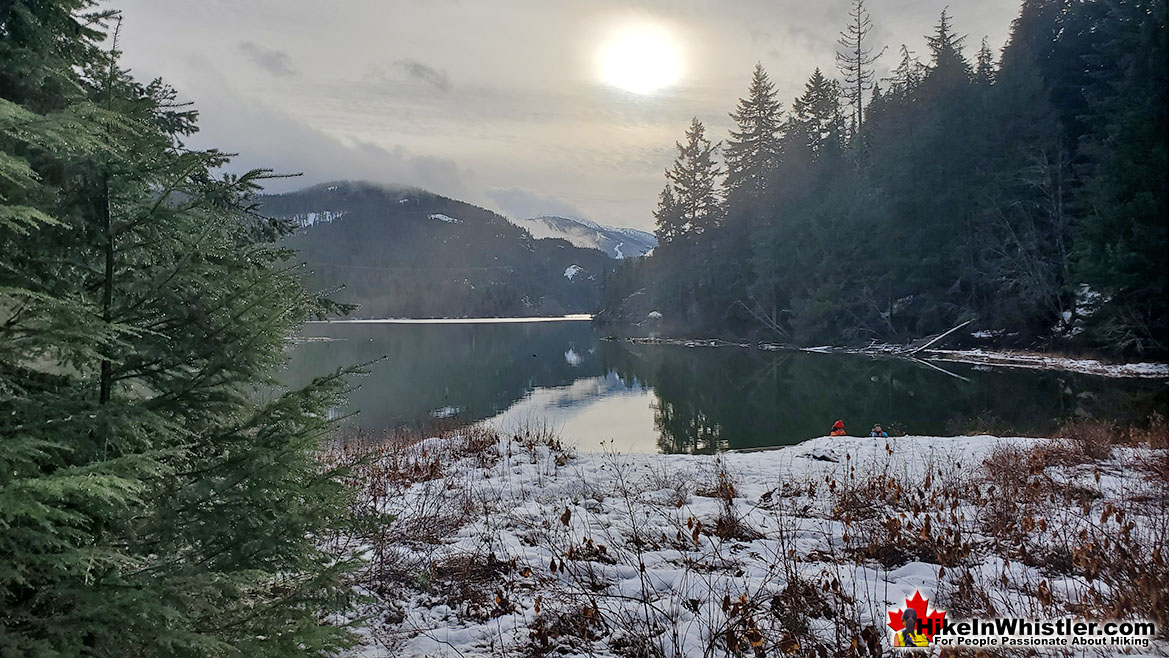
2013: Terry “Toulouse” Spence brought a box of the original posters to Whistler Museum. The museum sold the remaining posters from the original 10000 and was able to proudly boast that the original run of the Toad Hall poster sold out almost 45 years after it was first printed. Reprints of the original Toad Hall poster are currently available for purchase at the museum.
2017: Resort Municipality of Whistler purchased the Parkhurst lands (200acres/81 hectares), including the land where the famous Toad Hall picture was taken. The intent is to preserve the historic land and remaining features into a park, however it is likely to remain mostly unchanged for the foreseeable future.
Camping & Bivouacking at Parkhurst Ghost Town
![]()
![]() The places to put up a tent in and around Parkhurst are numerous and range from pretty good to incredible. One thing to keep in mind, however is that camping in Parkhurst is theoretically not allowed as it lays within the boundaries of the Resort Municipality of Whistler. This boundary incidentally ends at the Green River bridge at the Sea to Sky Highway turnoff to Wedgemount Lake (the bridge you cross to drive to the Parkhurst trailhead). This is why you tend to see camper vans and tents here all year-round. Canadian law allows for public camping on Crown Land and the land north of the bridge is Crown Land. There are several reasons why Parkhurst is only theoretically a no camping zone. The main reason of course is that the area is largely forgotten and for the most part wilderness. Another reason is that the train tracks running along the shore of Green Lake and the power lines that run through the area make the area, at first glance, not too appealing to visit. With wide swaths of trees cut down to accommodate power lines and noisy trains barreling through several times a day, it would be difficult to justify hassling a couple of campers visiting for a day or two.
The places to put up a tent in and around Parkhurst are numerous and range from pretty good to incredible. One thing to keep in mind, however is that camping in Parkhurst is theoretically not allowed as it lays within the boundaries of the Resort Municipality of Whistler. This boundary incidentally ends at the Green River bridge at the Sea to Sky Highway turnoff to Wedgemount Lake (the bridge you cross to drive to the Parkhurst trailhead). This is why you tend to see camper vans and tents here all year-round. Canadian law allows for public camping on Crown Land and the land north of the bridge is Crown Land. There are several reasons why Parkhurst is only theoretically a no camping zone. The main reason of course is that the area is largely forgotten and for the most part wilderness. Another reason is that the train tracks running along the shore of Green Lake and the power lines that run through the area make the area, at first glance, not too appealing to visit. With wide swaths of trees cut down to accommodate power lines and noisy trains barreling through several times a day, it would be difficult to justify hassling a couple of campers visiting for a day or two.
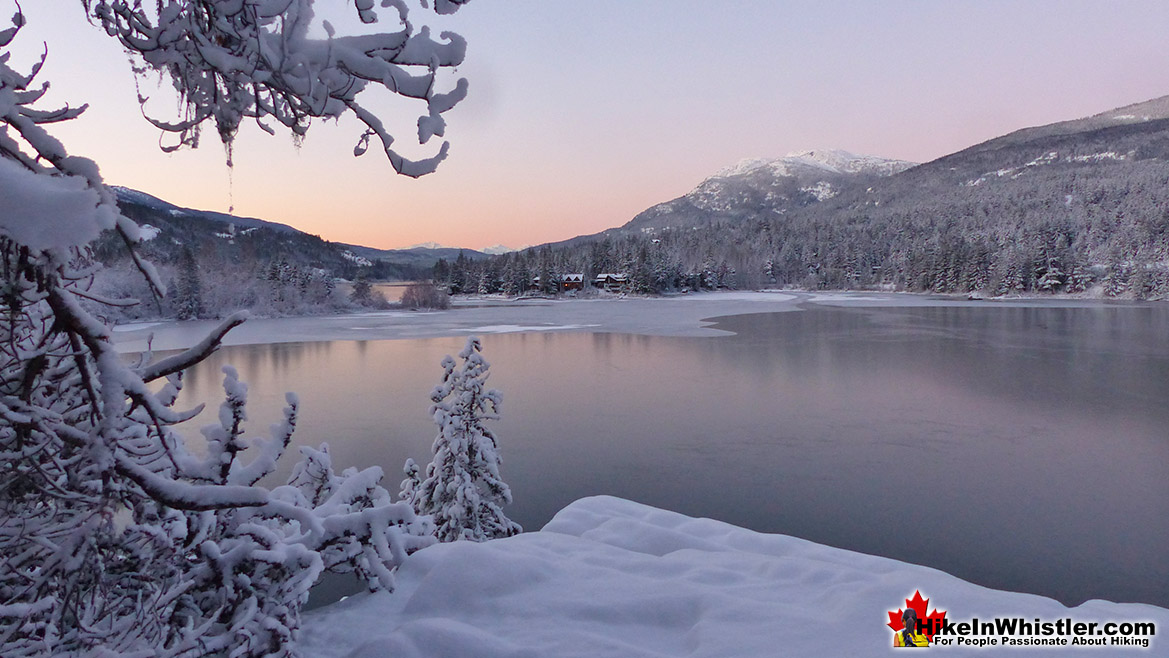
Also, the land was only purchased by Whistler in 2017, before that it was privately owned and seemingly forgotten by the owner. Yet another, and possibly the most important reason you can get away with camping in Parkhurst is that it almost always goes unnoticed. Deep forest, relatively quiet trails and a wonderfully spread out area has allowed the occasional campers to go unnoticed. Certainly, if hordes of campers descend on the area and put up tents for multiple days, you would see no camping enforcement. Hopefully that never happens and no trace, stealth campers continue to come and go unnoticed.
The land that once accommodated dozens of houses in Parkhurst is fairly flat and everywhere you look you spot an enticing place to put up a tent. The ridge overlooking Green Lake is particularly good as you can put your tent up at the edge of the cliff and your entire view is beautiful Green Lake and Mount Sproatt and Rainbow Mountain beyond. Back in the forest you get a more secluded feel and can easily find a spot where few hikers venture. Hiking in along the Parkhurst Trail you will notice several trails ascending up on your left. These lead to some beautiful rocky hilltops that are very secluded and very nice. These wide open hilltops have few trees and you get lots of sun as well as mountain views all around.
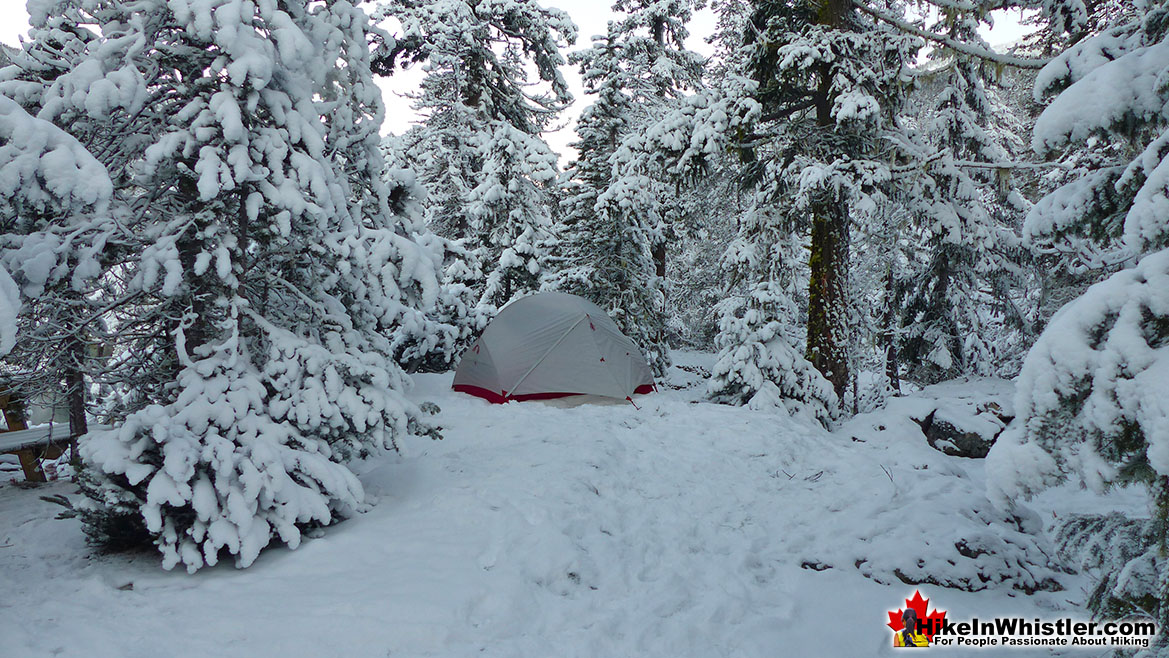
If you go down to the shore of Green Lake to where the giant tractor is you will notice that if you head along the shore of Green Lake along the train tracks north for about 200 metres you will come to some old cement foundations of the sawmill and some clearings hidden in the spooky forest there. This area has some positives and negatives. The bad of course is the train goes by at 2am and again at 6am, just 40 metres from your tent. If you don't mind that then this area is amazing. Spooky, though cute little forest, steps from the lake and nice, clean, grassy areas to wander around.
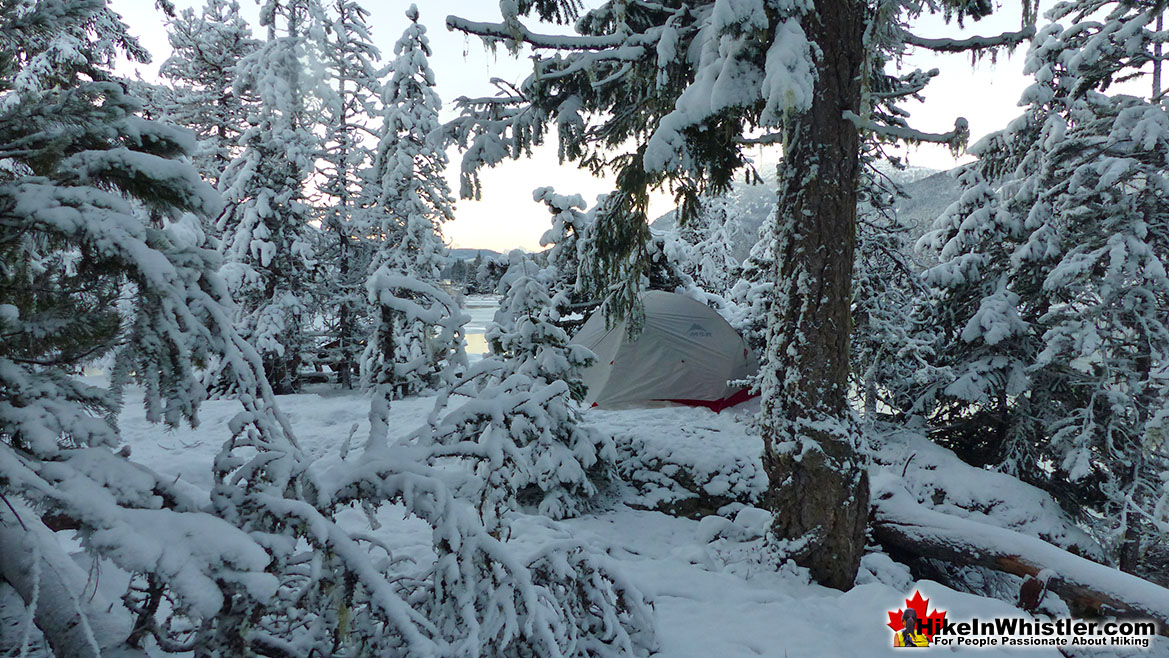
The same beautiful spot on Parkhurst Ridge in the summertime is a much different experience. The wide open areas on the ridge are fun to explore and aside from the small viewpoint, seldom visited. The further along the ridge you hike the further from humanity you seem to get. The ridge slowly ascends to the end of Green Lake and the start of Green River. When the old Soo Valley logging camp existed in the 1960's and early 70's there was a large log across the river acting as a bridge. With the bridge long gone, you now have to access this beautiful spot via a short trail from the highway or by boat.

One of the most interesting and beautiful places to camp in Parkhurst is in the triangle of land that juts out into Green Lake. When Parkhurst was an operational logging town this was the site of the sawmill. Today there is one railway line that passes through Parkhurst past the sawmill, but when the sawmill was running there was another rail line that veered off the main line and out to the sawmill near the end of the point of land. Another rail line ran parallel to the main line we see today and was used to load the cut lumber onto train cars. When operational there were almost no trees on this point of land and several buildings with metal roofs. The buildings are long gone, though the metal roofs remain on the ground. The forest has grown over and around these large sheets of metal and few can be seen today. You can be pretty sure that there is metal under your feet if you are in a clearing with no big trees. At the centre of the triangle of land is quite a large clearing with no big trees. This wonderfully sunny area is difficult to get to because of the almost impenetrable forest around it, but when you find it, it is serene and cut off from the world. Plenty of small gaps in the forest give you great views of Green Lake and getting to the shore is not too hard. Also, this old sawmill site is a treasure trove of old Parkhurst relics.

Though the old Parkhurst Sawmill site is the most interesting and wonderfully secluded and spacious place to camp, the top of the Parkhurst Ridge Trail is definitely the most spectacular. High above Green Lake along the ridge you will find a wide open, sunny area with the best views of Green Lake and snowy mountains all around. There are several flat rock outcrops along this cliff and fairly easy access to Green Lake. There is even a picnic table that someone constructed here a couple years ago. The Parkhurst Ridge trail runs through the beautiful forest here, snaking up and over several sunny hilltops before merging with the Parkhurst Trail about 1.4 kilometres from the Parkhurst Ridge viewpoint.
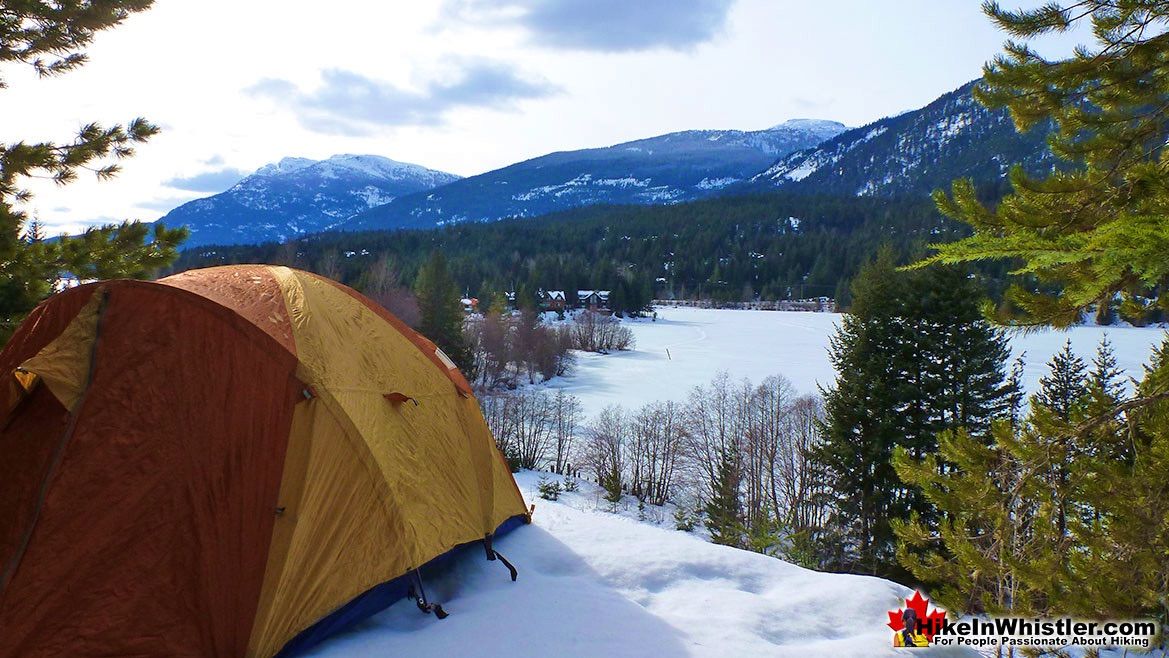
If you are a fan of history, you might revel in the fact that Parkhurst was the site of the iconic Toad Hall skiers poster from the early 70's. This picture can be seen at the Whistler Museum of several people posing in front of Toad Hall wearing nothing but ski boots. The old Toad Hall was located down at the end of Green Lake, across Green River. Green River is too big to cross, so you have to get to the old Toad Hall site by boat or by walking in from the Sea to Sky Highway. There is a small clearing on the right side of the highway just past the turnoff on your left to Cougar Mountain. Just a short walk through the forest leads to the sand and gravel clearing where several small houses and Toad Hall once stood. The famous Toad Hall photo was taken to commemorate the short, but lively history of the area shortly before the houses were demolished.
Walking to Parkhurst From Green Lake Park
![]() For a few weeks every year Green Lake freezes enough to walk across from Green Lake Park. Usually by late January and much of February the lakes in Whistler freeze solid enough to walk and skate on. The problem, of course, is that it is sometimes tricky to know for sure a lake is safe enough to cross. It usually seems to take a couple weeks of at least -8c to freeze thick enough. Green Lake Park is directly across from Parkhurst and you can walk there in 5 minutes if you determine it is safe enough to cross. Green Lake Park is easy to find along Lakeshore Drive, just an 8 minute drive north of Whistler Village. Finding Parkhurst across Green Lake is easy. You just aim for the huge, abandoned tractor perched on the edge of the lake. A trail goes through the trees, across the tracks and up into Parkhurst.
For a few weeks every year Green Lake freezes enough to walk across from Green Lake Park. Usually by late January and much of February the lakes in Whistler freeze solid enough to walk and skate on. The problem, of course, is that it is sometimes tricky to know for sure a lake is safe enough to cross. It usually seems to take a couple weeks of at least -8c to freeze thick enough. Green Lake Park is directly across from Parkhurst and you can walk there in 5 minutes if you determine it is safe enough to cross. Green Lake Park is easy to find along Lakeshore Drive, just an 8 minute drive north of Whistler Village. Finding Parkhurst across Green Lake is easy. You just aim for the huge, abandoned tractor perched on the edge of the lake. A trail goes through the trees, across the tracks and up into Parkhurst.
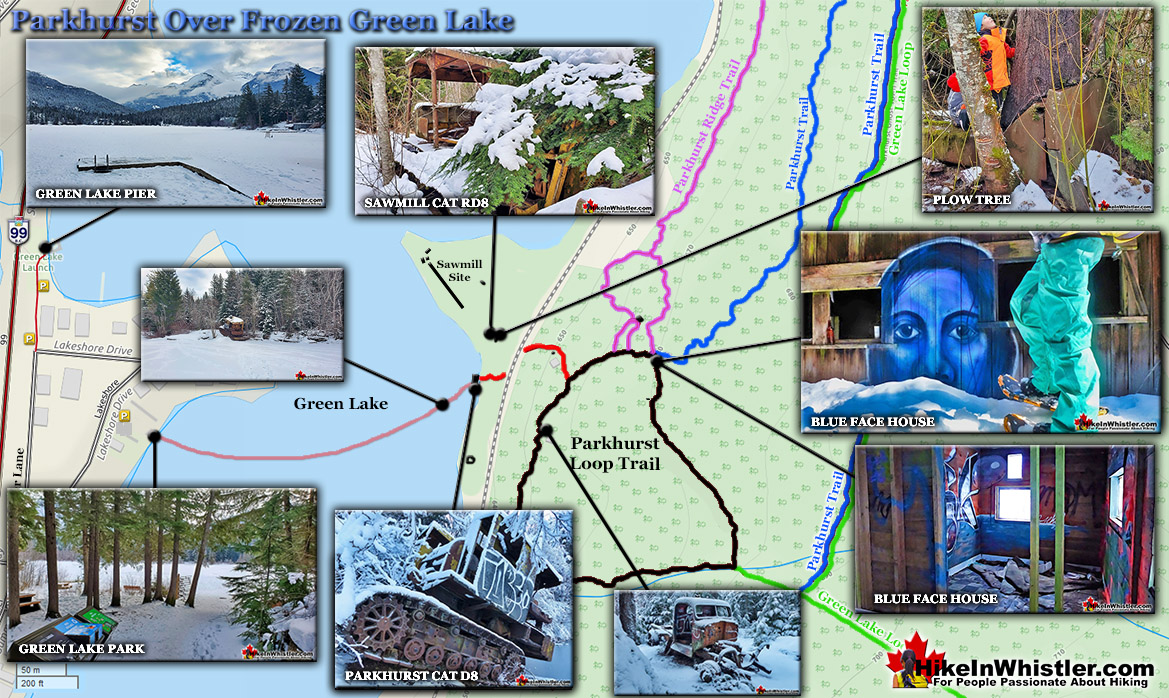
Trailhead & Parking Directions to Parkhurst Ghost Town
![]() As mentioned above there are several ways to access Parkhurst, but the access from the Wedgemount Lake turnoff on the Sea to Sky Highway is the most direct if arriving on foot or bike. If you zero your odometer at Village Gate Blvd in Whistler Village and drive north on Highway 99, at 11.9 kilometres you will see the Wedgemount(Garibaldi) turnoff on your right. Turn here, cross the train tracks and then the bridge over Green River. Turn right and drive 1 kilometre up the old logging road to the unmarked Parkhurst trailhead near the two yellow gates. Depending on the snowfall you can usually drive to the Parkhurst trailhead parking well into November and sometimes December. Usually by December until March there will be too much snow for most vehicles to get up the snowy road. Some winters you can't get across Green River due to deep snow and have to park on the highway side of Green River in the small parking area. During most winters you will find the snow packed down by previous vehicles and you can drive across the bridge and find a lot of places to park across the bridge at the large T junction. Either way you will still have to snowshoe an extra kilometre up the somewhat boring logging road to the normal trailhead. Shown here is the parking area next to the Sea to Sky Highway (Hwy 99), between the highway/train tracks and the Green River bridge. From here you just have to snowshoe across the bridge, then turn right and snowshoe up the logging road for 1 kilometre to the Parkhurst trailhead.
As mentioned above there are several ways to access Parkhurst, but the access from the Wedgemount Lake turnoff on the Sea to Sky Highway is the most direct if arriving on foot or bike. If you zero your odometer at Village Gate Blvd in Whistler Village and drive north on Highway 99, at 11.9 kilometres you will see the Wedgemount(Garibaldi) turnoff on your right. Turn here, cross the train tracks and then the bridge over Green River. Turn right and drive 1 kilometre up the old logging road to the unmarked Parkhurst trailhead near the two yellow gates. Depending on the snowfall you can usually drive to the Parkhurst trailhead parking well into November and sometimes December. Usually by December until March there will be too much snow for most vehicles to get up the snowy road. Some winters you can't get across Green River due to deep snow and have to park on the highway side of Green River in the small parking area. During most winters you will find the snow packed down by previous vehicles and you can drive across the bridge and find a lot of places to park across the bridge at the large T junction. Either way you will still have to snowshoe an extra kilometre up the somewhat boring logging road to the normal trailhead. Shown here is the parking area next to the Sea to Sky Highway (Hwy 99), between the highway/train tracks and the Green River bridge. From here you just have to snowshoe across the bridge, then turn right and snowshoe up the logging road for 1 kilometre to the Parkhurst trailhead.
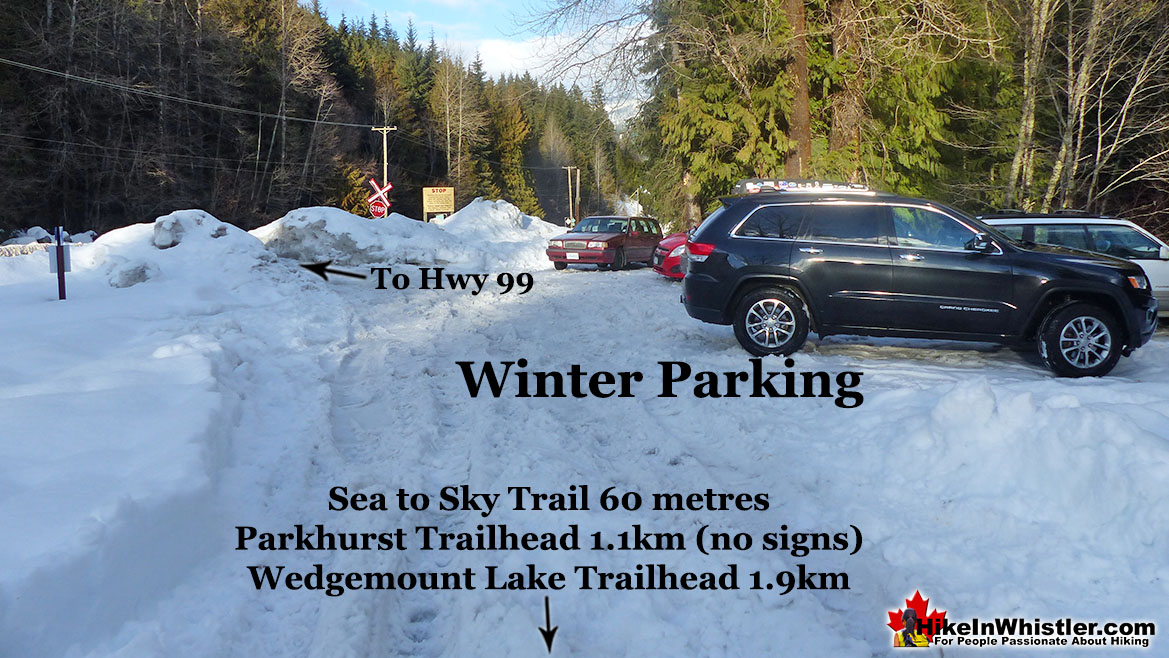
The picture below is the T junction after you cross the Green River bridge. Quite often during the winter this usually wide open area is accessible to cars and more convenient to park, though it is still a kilometre from the Parkhurst trailhead. At this T junction you will see plenty of signs for Wedgemount Lake and the Sea to Sky Trail. The gravel road extending in both directions is overlapped by the Sea to Sky Trail and the Sea to Sky Trail veers off to the left just before you reach the Parkhurst trailhead.
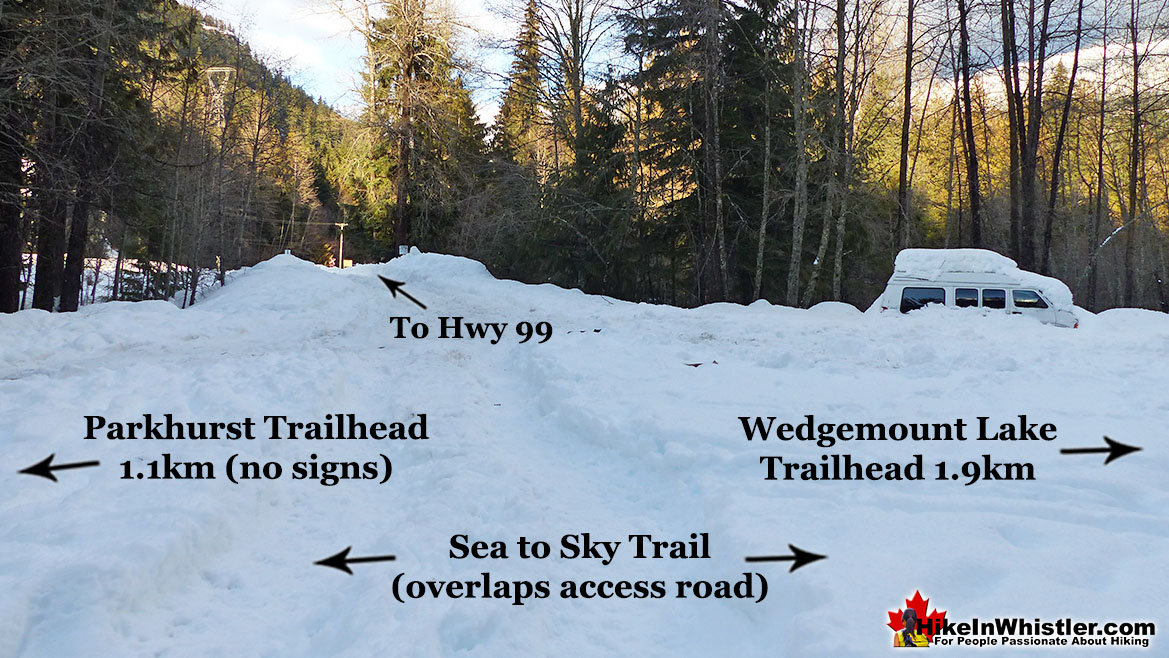
During the trek to the trailhead you will pass Whistler Paintball on your left.

A couple hundred metres after passing the Whistler Paintball sign you will see two yellow gates on your left. The second yellow gate, hidden by snowy trees in the picture below, is the continuation of the Sea to Sky Trail which extends up behind Parkhurst and further up behind Green Lake and comes out at Lost Lake and Whistler Village. Lost Lake is not accessible during the winter when there is snow on the ground as the trails are groomed for cross country skiing and there is an entrance fee. Part way along the Sea to Sky Trail you can connect to Parkhurst via the Parkhurst Loop Trail and return via the Parkhurst Trail. This is a nice loop trail and on very snowy days the Sea to Sky Trail is much easier to follow than the often zigzagging and hilly Parkhurst Trail.
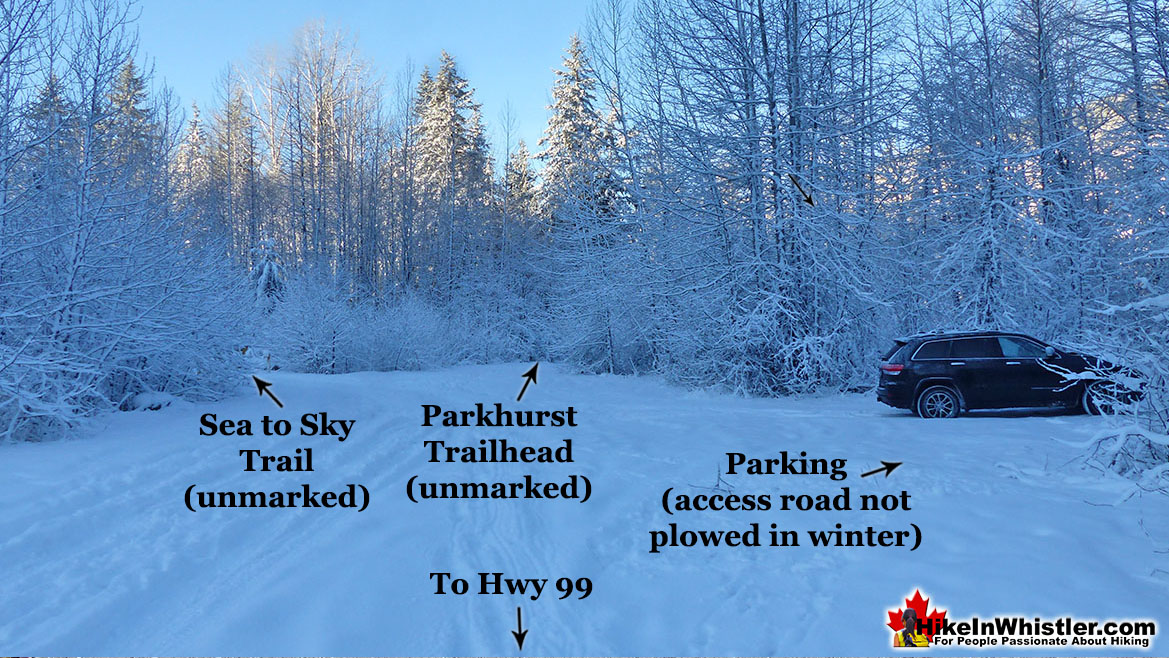
Keep snowshoeing straight ahead passing the yellow gates and Sea to Sky Trail on your left and you will come to a cement barrier to prevent cars from continuing. This is the start of the Parkhurst Trail which quickly enters the forest and then crosses the old, disintegrating, decommissioned vehicle bridge over Wedge Creek. It is solid enough for pedestrians on the right side, though you will see plenty of large holes and sketchy sections as you cross. In the winter you will see a couple of orange marker sticks indicating the left side is dangerous to cross, especially if the holes are obscured by snow.
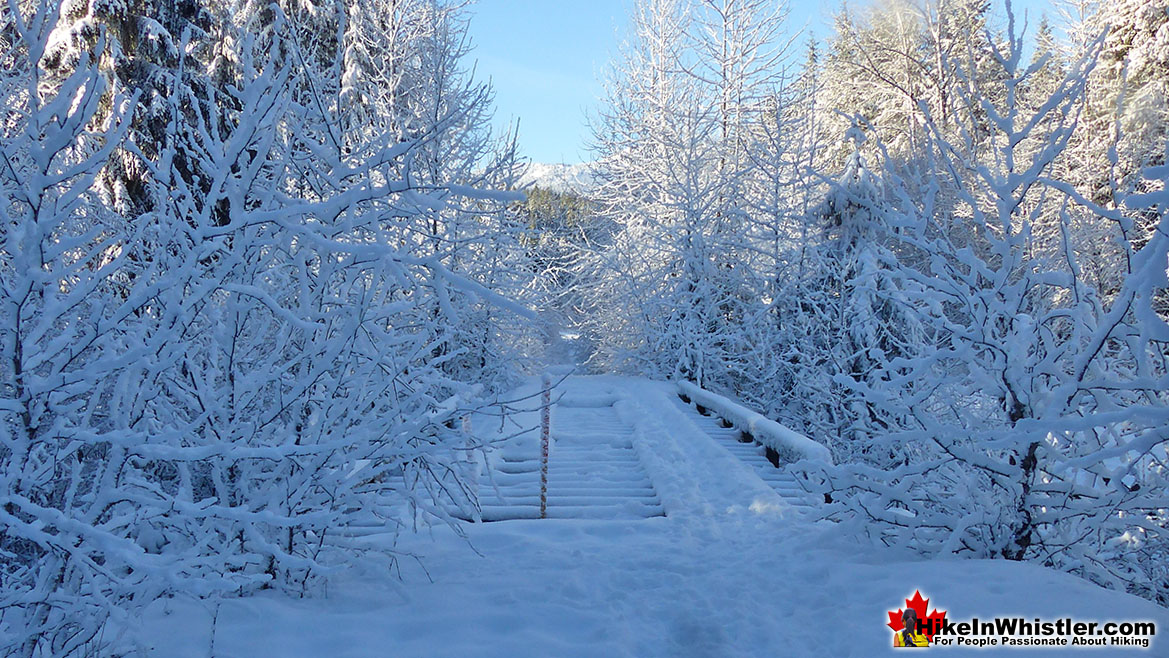
After crossing Wedge Creek bridge you enter a winter wonderland and soon come out of the trees and enter the large open area where trains can turn around. In railroad terminology this large Y shaped area is called a wye.
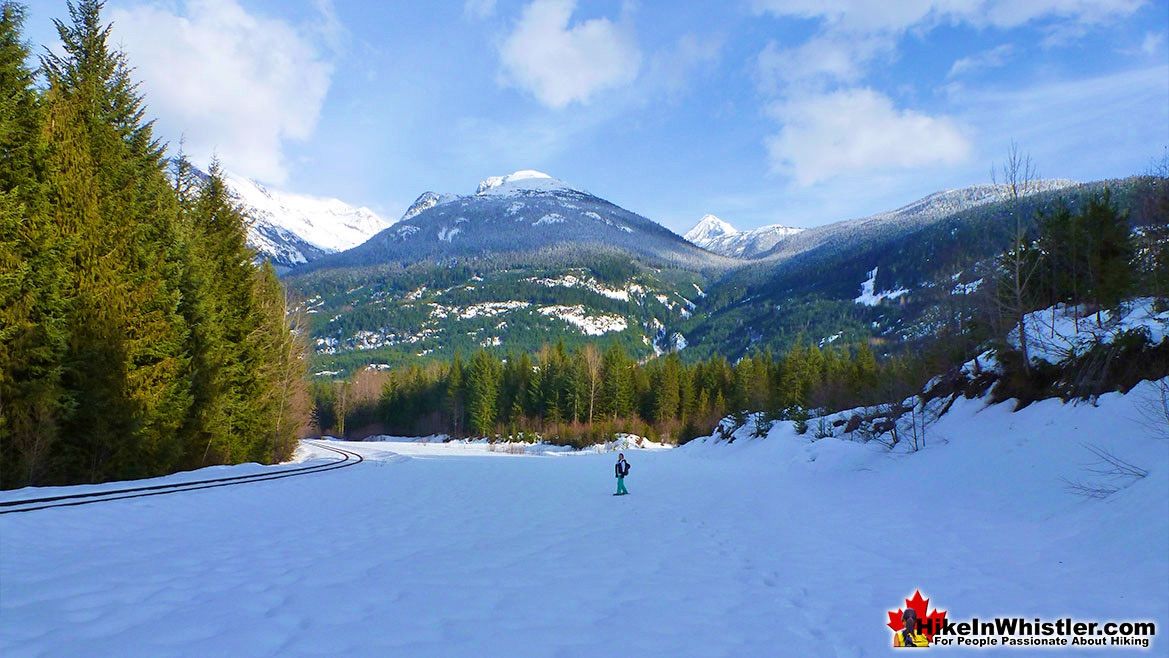
You continue across the wye by snowshoeing parallel to the train tracks that run along the forest on the right. Don't follow the tracks that bend to the left and come to the end of the wye. Following the main train tracks with the forest on your right when the tracks from the wye merge again you will see a trail on your left enter the forest and a small sign for the Green Lake Loop Trail/Parkhurst Trail.
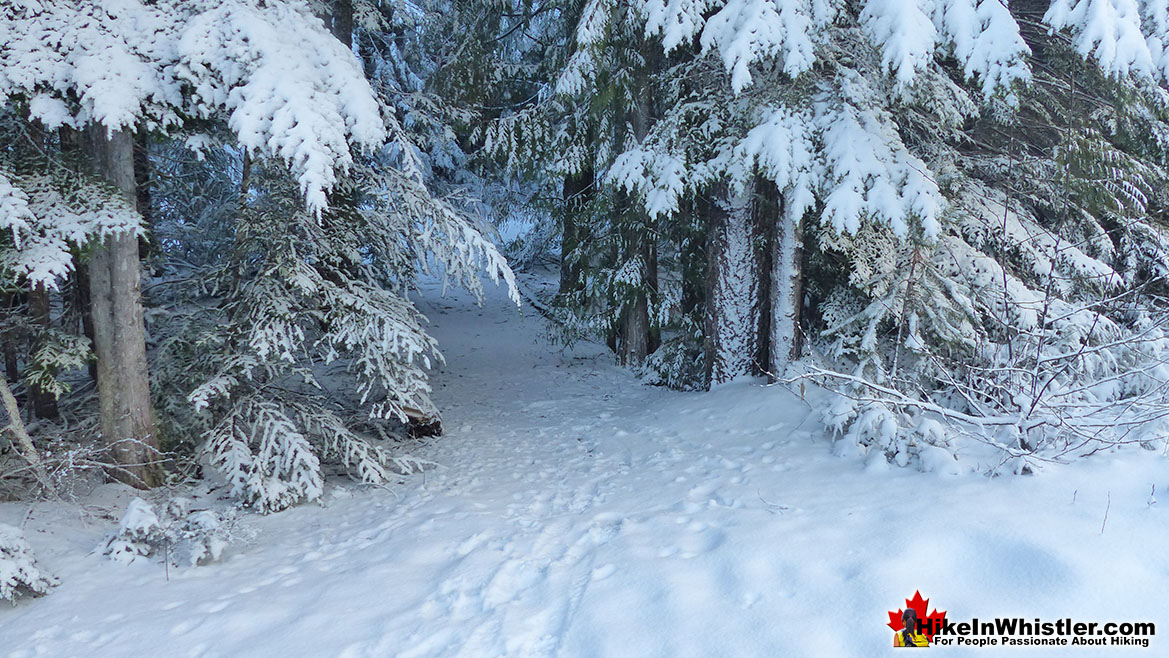
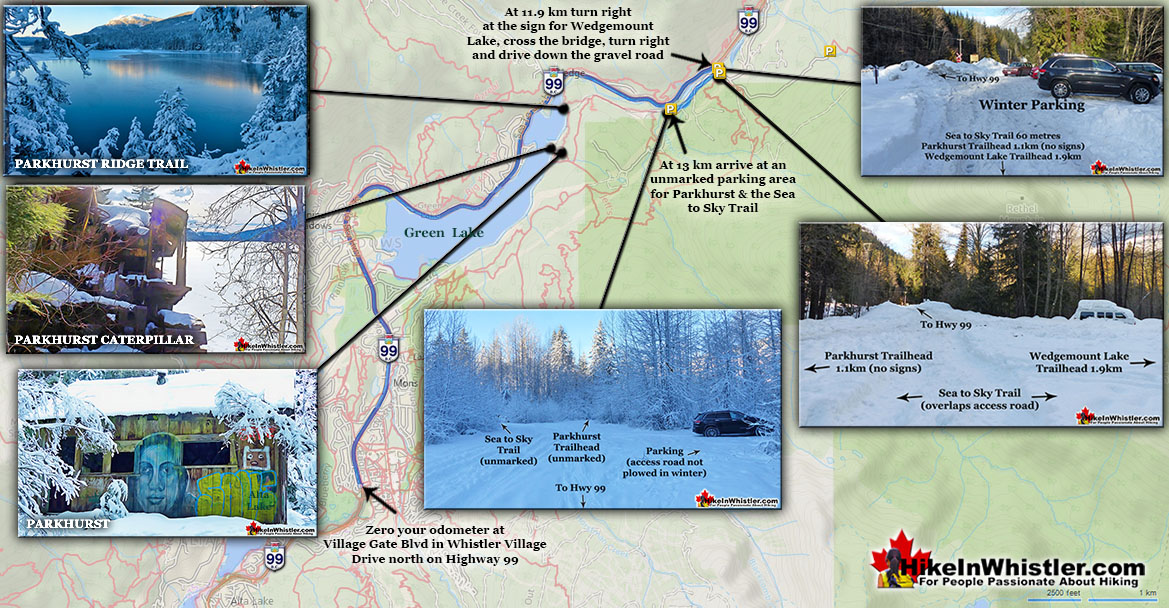
More Whistler Snowshoe Trails
![]() There are plenty of beautiful and free snowshoe trails in Whistler and Garibaldi Provincial Park. From the surreal paintings of Whistler Train Wreck to the magnificent mountain serenity of Wedgemount Lake in Garibaldi Park. Trails range from extremely easy, like the short, flat trails to Brandywine Falls and Rainbow Park. To challenging and long trails to places like Elfin Lakes, Taylor Meadows and Wedgemount Lake. Whistler even has a growing network of snowshoe trails to Parkhurst Ghost Town on the far side of Green Lake. There are a couple pay-use snowshoeing areas in Whistler, however most free trails are as good or better. Whistler Train Wreck is an easy/moderate snowshoe trail that takes you through a deep forest, over Cheakamus River via a very pretty suspension bridge, and to a series of decades old, wrecked train cars. Elfin Lakes in Garibaldi Provincial Park is another beautiful place to snowshoe. Located at the south end of Garibaldi Park, the Elfin Lakes trailhead is found in Squamish. The trail is not overly difficult, however it is quite long. A consistently uphill, 11 kilometre(13.7 mile) trail through some spectacular scenery takes you to the marvelous Elfin Lakes hut. For easier snowshoeing, Rainbow Falls is a good option. Located just a short drive from Whistler Village, the Rainbow Trail is a beautiful trek through the forest in a winter wonderland to a hidden waterfall surrounded by deep pillows of powdery snow. For more challenging snowshoeing, Joffre Lakes Provincial Park is hard to beat. A long, though beautiful drive into the mountains, north of Pemberton takes you to this moderately challenging, 11 kilometre(6.8mile) roundtrip snowshoe trail. The frequently steep, winding trail takes you through a winter paradise and around, or over three frozen lakes.
There are plenty of beautiful and free snowshoe trails in Whistler and Garibaldi Provincial Park. From the surreal paintings of Whistler Train Wreck to the magnificent mountain serenity of Wedgemount Lake in Garibaldi Park. Trails range from extremely easy, like the short, flat trails to Brandywine Falls and Rainbow Park. To challenging and long trails to places like Elfin Lakes, Taylor Meadows and Wedgemount Lake. Whistler even has a growing network of snowshoe trails to Parkhurst Ghost Town on the far side of Green Lake. There are a couple pay-use snowshoeing areas in Whistler, however most free trails are as good or better. Whistler Train Wreck is an easy/moderate snowshoe trail that takes you through a deep forest, over Cheakamus River via a very pretty suspension bridge, and to a series of decades old, wrecked train cars. Elfin Lakes in Garibaldi Provincial Park is another beautiful place to snowshoe. Located at the south end of Garibaldi Park, the Elfin Lakes trailhead is found in Squamish. The trail is not overly difficult, however it is quite long. A consistently uphill, 11 kilometre(13.7 mile) trail through some spectacular scenery takes you to the marvelous Elfin Lakes hut. For easier snowshoeing, Rainbow Falls is a good option. Located just a short drive from Whistler Village, the Rainbow Trail is a beautiful trek through the forest in a winter wonderland to a hidden waterfall surrounded by deep pillows of powdery snow. For more challenging snowshoeing, Joffre Lakes Provincial Park is hard to beat. A long, though beautiful drive into the mountains, north of Pemberton takes you to this moderately challenging, 11 kilometre(6.8mile) roundtrip snowshoe trail. The frequently steep, winding trail takes you through a winter paradise and around, or over three frozen lakes.
More Whistler & Garibaldi Park Snowshoe Trails!
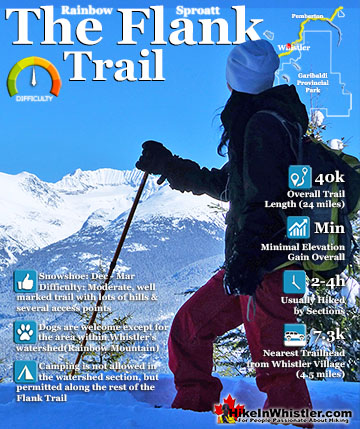
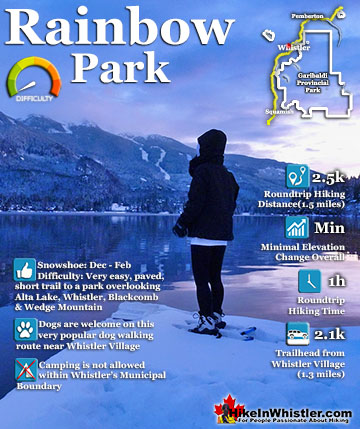
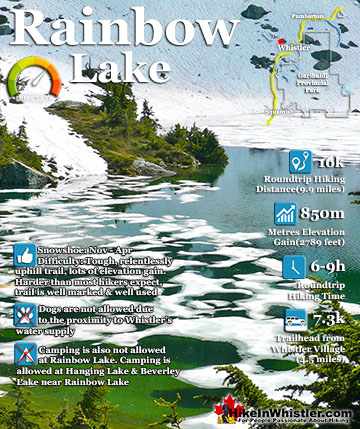
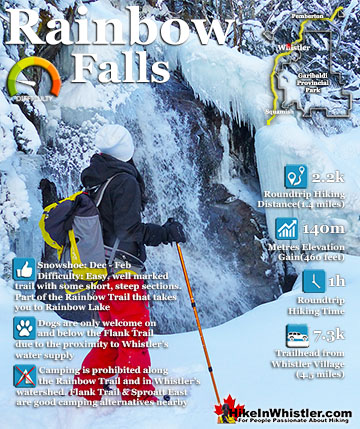
Where to Hike in Whistler & Garibaldi Park by Month
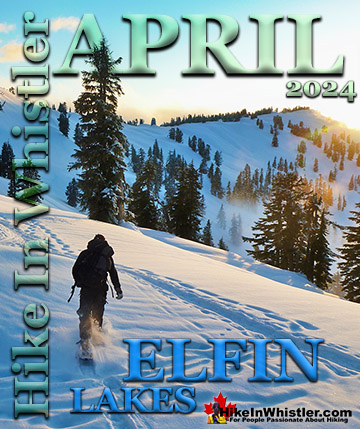
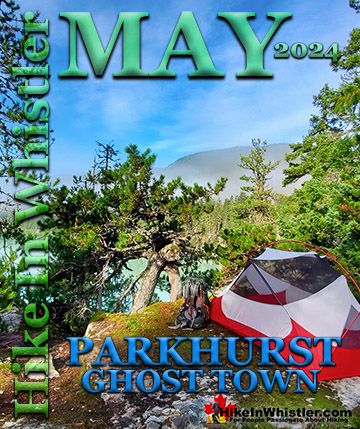

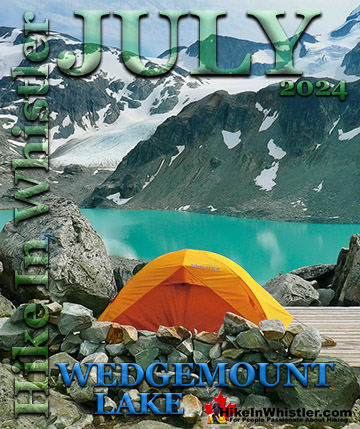
Amazing Whistler & Garibaldi Park Hiking Trails!
